Before building Jim W4LF’s Hobbydyne™ crystal set, I put together an impedance matchbox, for matching the detector diode to a variety of different headsets and earphones, so that I could determine the best ones to use. The world of serious crystal set listening was new to me, so I did some reading up. To give you an idea of how serious this gets, many committed crystal set listeners have heard over 100 different stations on their sets, on the AM broadcast band (thanks to nighttime skywave propagation)!
It appeared that there are a few different kinds of headset that crop up often as being the favored types among crystal set enthusiasts. Of these, perhaps the most storied is the Baldwin Type C radio headset, or “Baldies” as their owners affectionately call them –
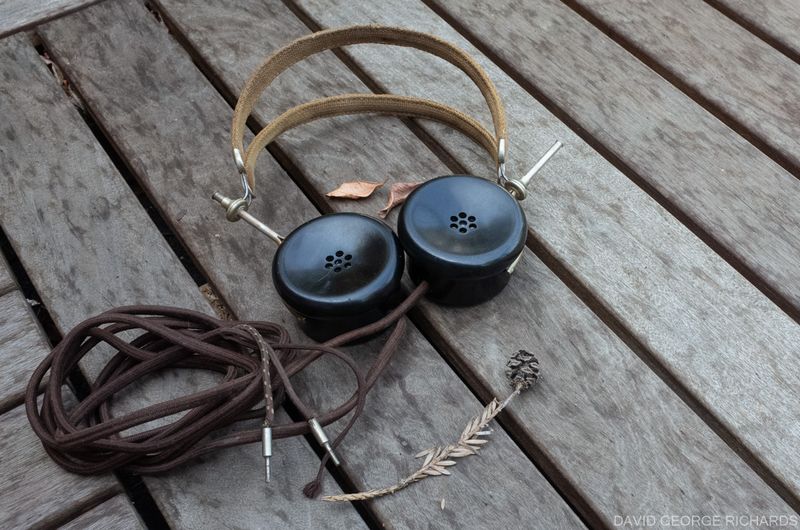
There are a couple of reasons why crystal set aficionados often have a set of Baldies in their collection. One of these is for their historical significance. Baldwins are considered to be the first mass-produced headset that significantly resembles modern headphones. Developed by Nathaniel Baldwin in Utah in the early part of the 20th century, they were first patented in 1910. He got his big break after sending 4 pairs to the US Navy. They were very impressed with their sensitivity and performance, and put in an initial order for a hundred pairs. Baldwins were a high quality headset. In the early 1920’s a set cost $14-$16 – about $250 in today’s money.
The other main reason for their continued popularity with crystal set folk, is that even by modern standards, they are quite sensitive. The design is different from most other headsets of the era, being that they employ a balanced armature and a mica diaphragm. A small proportion of Baldwin headsets had a phenolic diaphragm, and were slightly less sensitive as a result. It’s easy to tell if your Baldwins have mica diaphragms. If you unscrew the ear caps and see clear diaphragms like this, yours are mica –
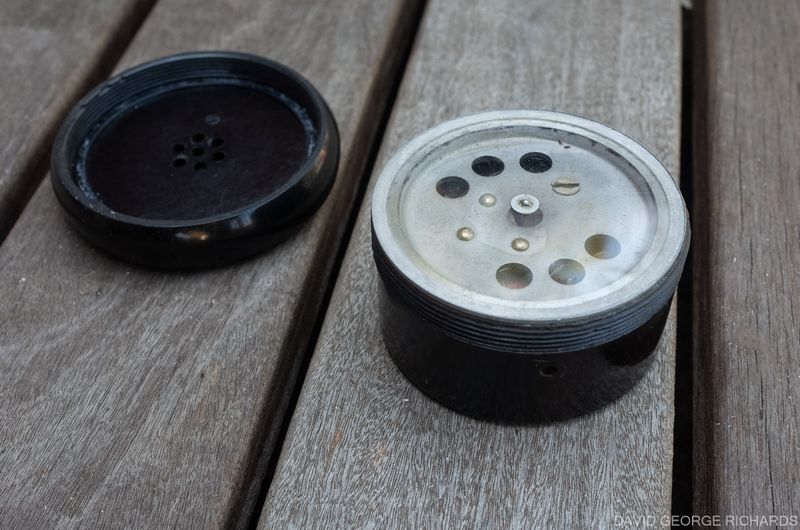
Here’s a view of the bottom of the element. Looking at it from this angle requires that the diaphragm side is downwards. Do not set it in this orientation without placing it on top of the ear cap, as you could damage the diaphragm or the drive rod (see how, in the above picture, the very end of the drive rod protrudes very slightly above the level of the diaphragm?) In this following view, if you look carefully, you can how the plate (circled) that supports the drive rod, is centered between the two poles of the magnet. This is how it should be – slap bang in the center, and not touching one or other of the poles –
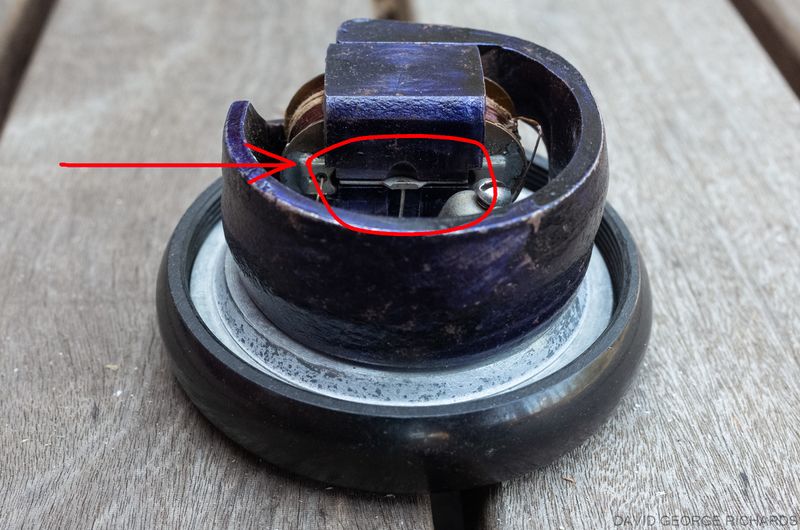
Looking straight down at the back of the element, you can see the 2 screws that are used to connect the ends of the headphone cords. I wish that modern headsets were as simple to disassemble and reassemble as these vintage models are –

Scott (from oldheadphones.com) is a big collector of vintage headsets. He told me that of the Baldwin headsets he has seen that have weak output, it has rarely been because of weak magnets, especially with the units that have purple painted magnets, as seen above. I believe that the purple painted magnet variety are far more common than the other type, which have black painted magnets. If your Baldwins have weak output, things to look for, Scott advised me, are armature plates that are not centered between the magnet poles, or are actually touching one of the poles (keep an eye out for debris between the plate and the poles). Another thing to look for, is warped or broken diaphragms.
Nathaniel Baldwin’s story is an interesting and dramatic one. Read it here – it’s well worth it. My Baldwins, like most of the vintage parts and gear I acquire, came from eBay and, contrary to what seems to be popular opinion, overpaying is not necessarily the norm. As the buyer, the power is in your hands. I paid US$15 + $12 shipping for these, which I think was a very fair price. I did clean them up, but only a little. This is the condition they arrived in, which wasn’t bad at all –
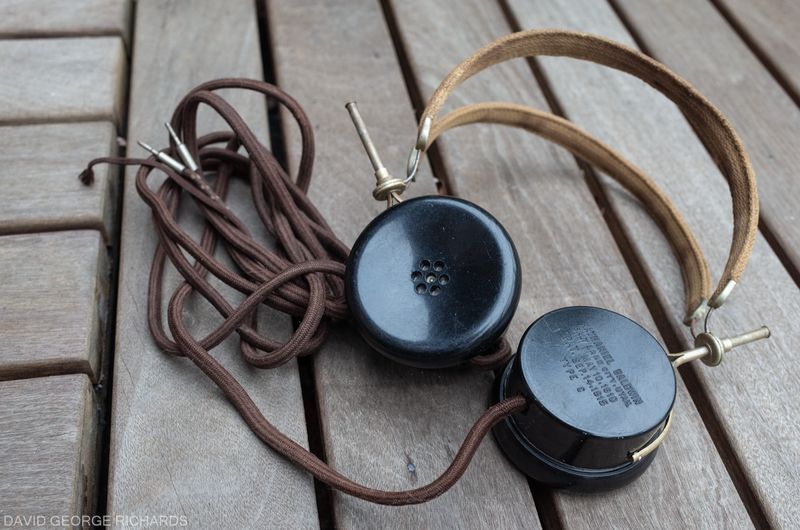
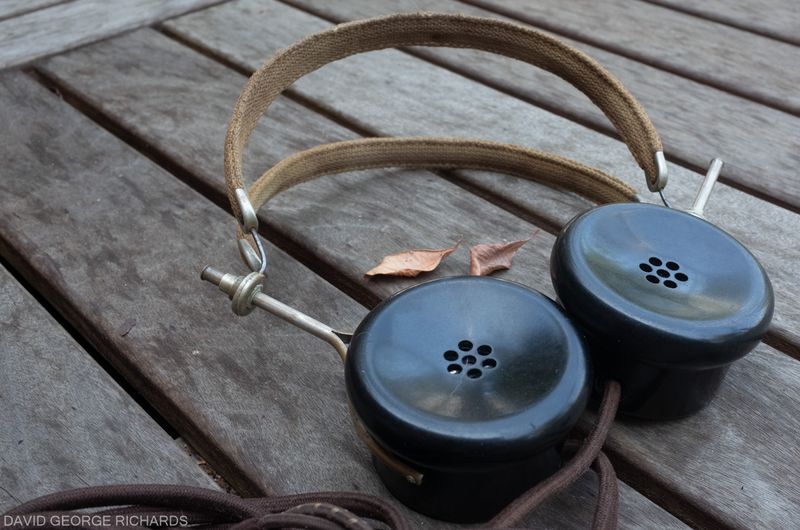
They were in pretty good shape, the main areas in which some shabbiness could be seen being in the headband, which showed very little fraying, though there was some dirt and stains present, and just a small amount of corrosion on the metal parts –
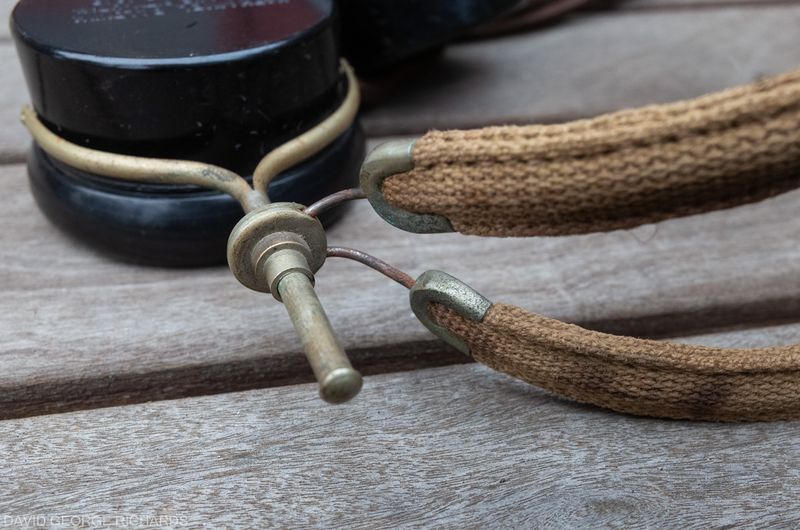
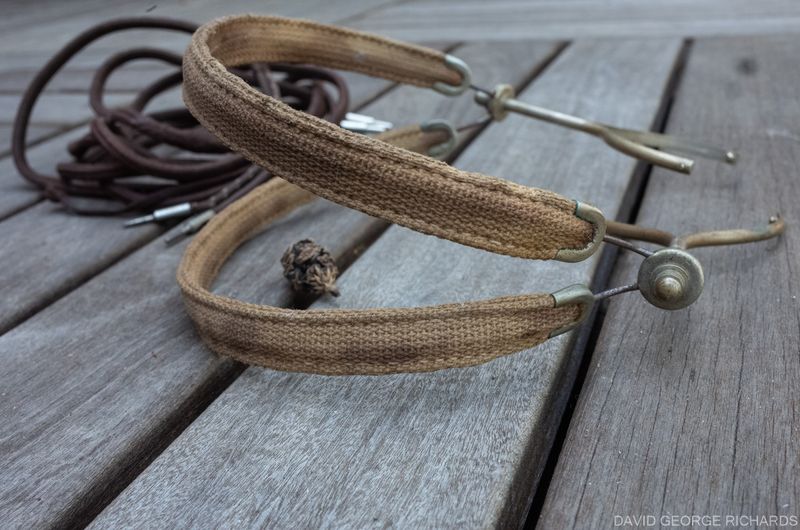
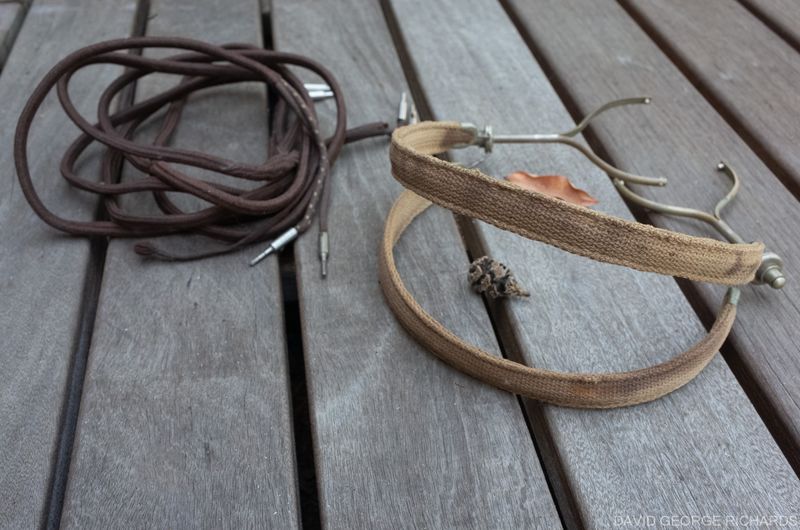
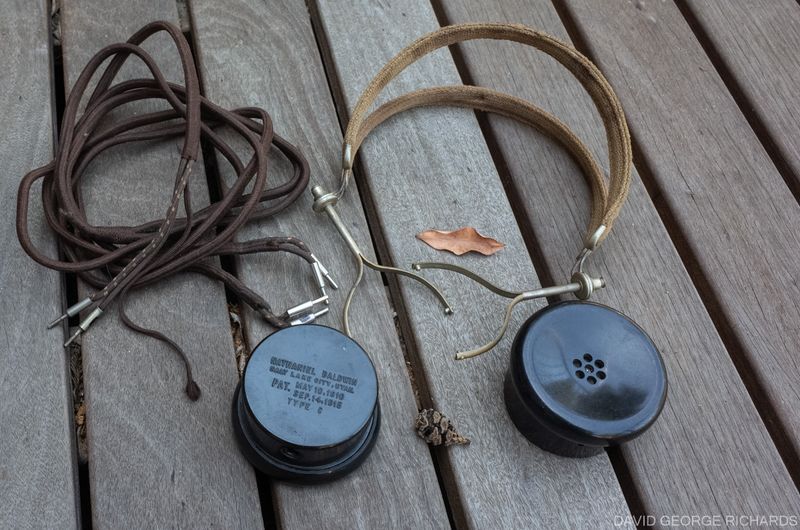
Scott from oldheadphones.com has a useful page on the restoration of old headphones. On this page, he is specifically referencing Western Electric 509-W’s, but the same advice can be applied to other types. Following this advice, I gave the metal parts of the Baldies a very light polish with Brasso (only very cursory, as I really wasn’t that bothered with making them gleam), and cleaned the bakelite earcups up a little with Bon Ami, which is a very minimally abrasive household cleaner. The construction of these headsets makes it very easy to take them apart for cleaning. The headphone cord unscrews from the elements – no soldering needed, and the elements themselves can be taken out from the bakelite earcups with no unscrewing at all – they simply drop out. It is a pleasingly very modular type of construction.
He also gave me some useful advice on cleaning the cords and headbands via email. Following this advice, I sprayed some prewash onto the headband, left it to soak for a short while, then immersed it for a while in a basin of cold soapy water, made with clothes detergent, while giving it a light scrubbing with an old toothbrush. Be careful when doing this, as the old fabric can fray quite easily. Then I rinsed it with cold water and left it out to dry overnight. I didn’t do anything with the cord, as it was in good shape. Incidentally, if you can buy something from him, it helps to fund his hobby of collecting vintage headsets.
Here’s the result. You can see the most improvement in the condition of the headband. Not gleaming, but with the aura of respectability that comes with the evidence of having lived an honest working life –
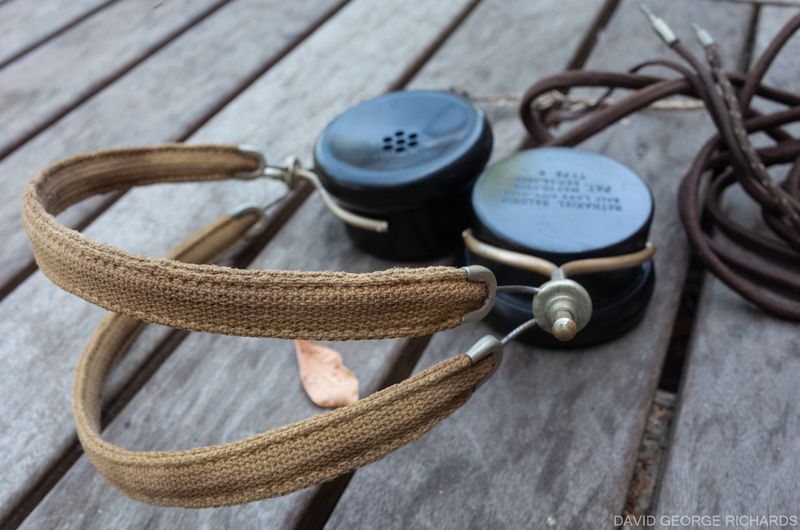
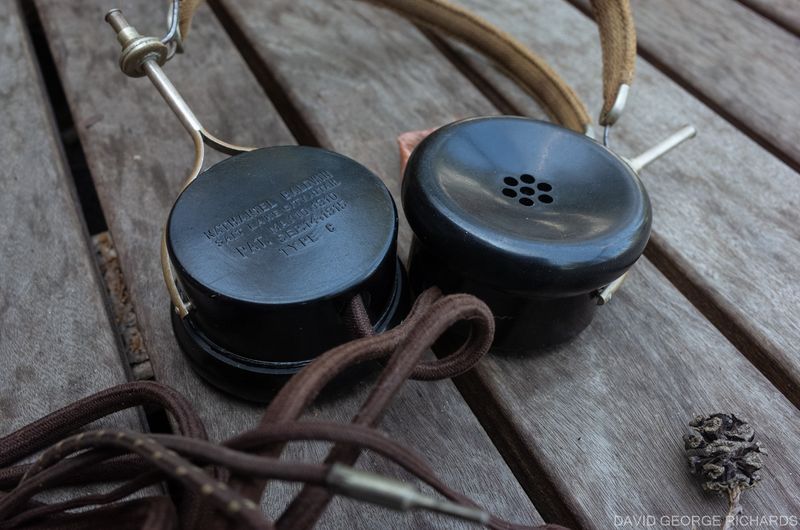

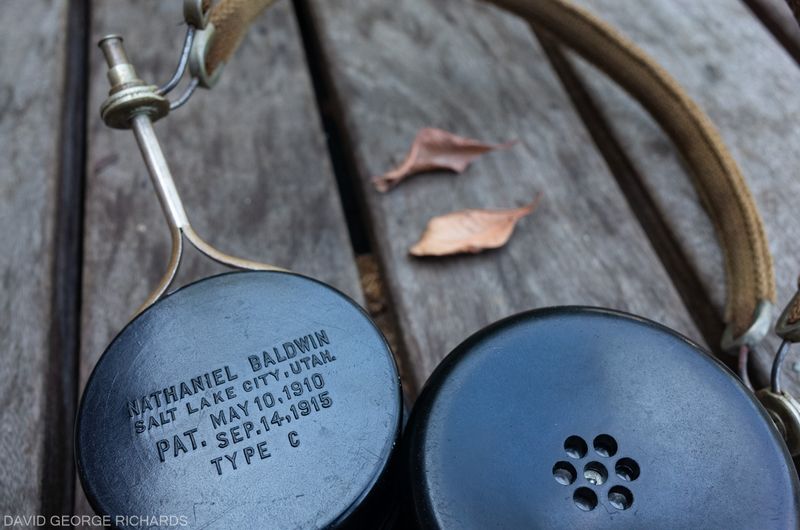
A very usable pair of Baldwins for everyday use, I think!
While on the subject of Nathaniel Baldwin Type C headsets, I want to share with you a very exciting find that I made while looking for the everyday use pair above. This was also on eBay and, unlike with the above pair, I paid quite a lot for these. They are a set of completely unused Baldwins, in the original box, with the instruction leaflet. The box was a little banged and frayed, but the headset was mint, and looked as if it had never even been assembled, let alone used! I am not an experienced collector of these but, on seeing them, something told me that it was not very common to see a pair in this condition. I ummed and aahed over them, told myself I wasn’t going to pay that much for them, and moved on. Shortly after, I came back, and opened up a correspondence with the seller. He had bought them at an estate sale 30 years ago, he told me, and they had been in storage ever since. He wasn’t sure if they worked, and didn’t know how to test them, but he did own a multimeter. I told him how to do a continuity check on the coils, and they tested out fine. This pushed me over the edge and, after a bit of back and forth, we agreed on a price. They were mine!
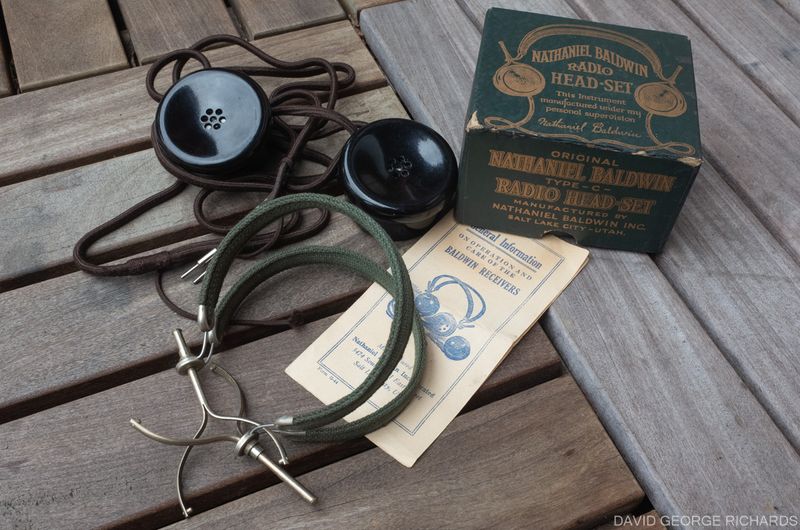
I hadn’t seen a pair of Baldies with a green headband before. I think it looks very handsome!
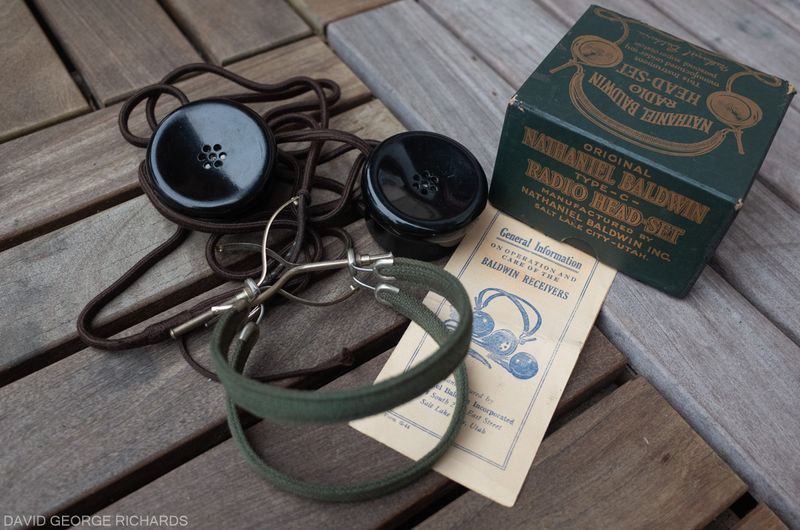
This model was first patented in 1910, and the entire Baldwin operation closed down between 1930 and 1932, so I think it’s fair to say that they are about 100 years old. It’s hard to put into words the appeal of seeing a product that has been sitting in it’s original box for 100 years, in the same unused state the original buyer would have seen it. I can’t help but wonder how this came about. Perhaps this headset sat on the shelves of a radio store somewhere that went out of business and then, along with other remaining stock, was sold, and sat in storage for years? Perhaps it was purchased by a well-heeled customer who bought it and forgot about it?
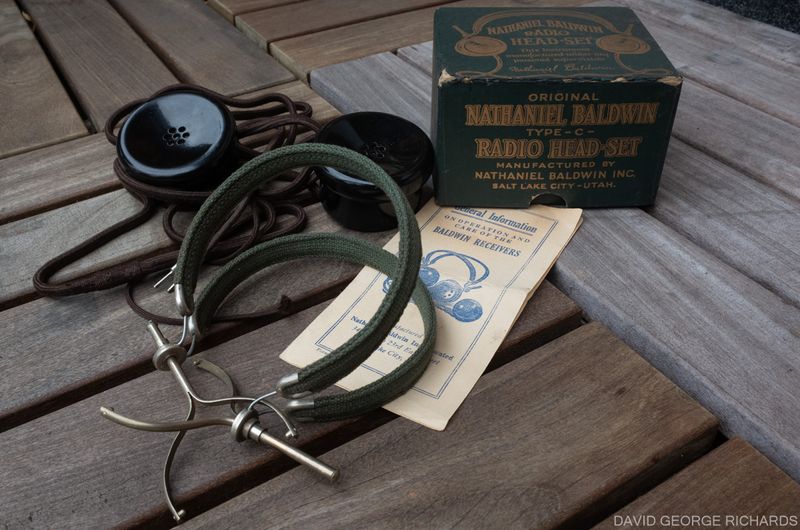
Just look at that shiny bakelite ear cap, that completely clear mica diaphragm, and that shiny metal, without nary a smidgin of corrosion in sight. Magnificent!
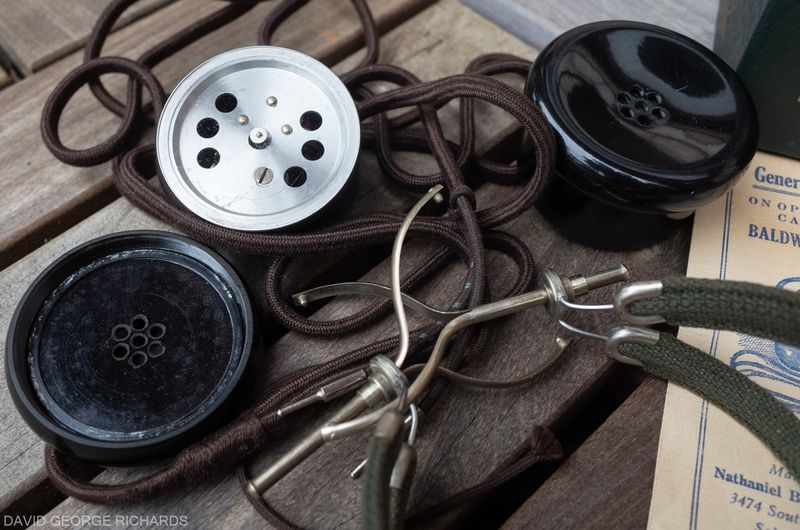
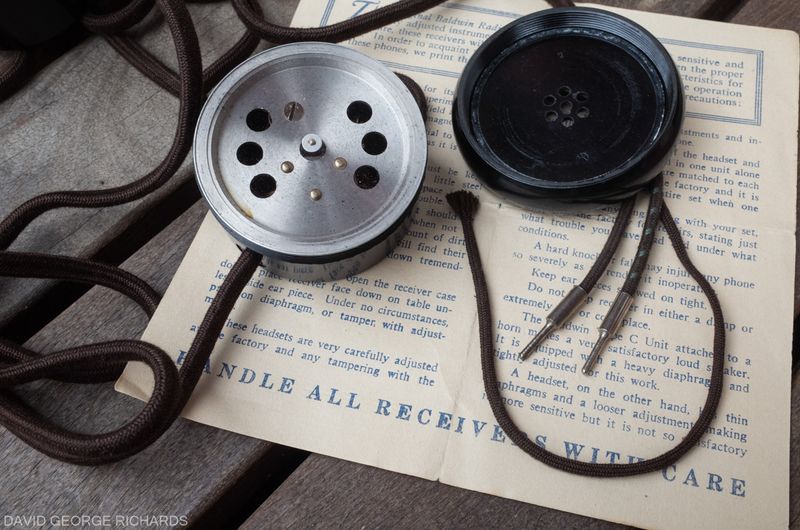
I mean, if you could get in a time machine, walk down Radio Row in NYC in the 1920’s, dive into a store and buy a pair of Baldwins, this is exactly what they’d look like –
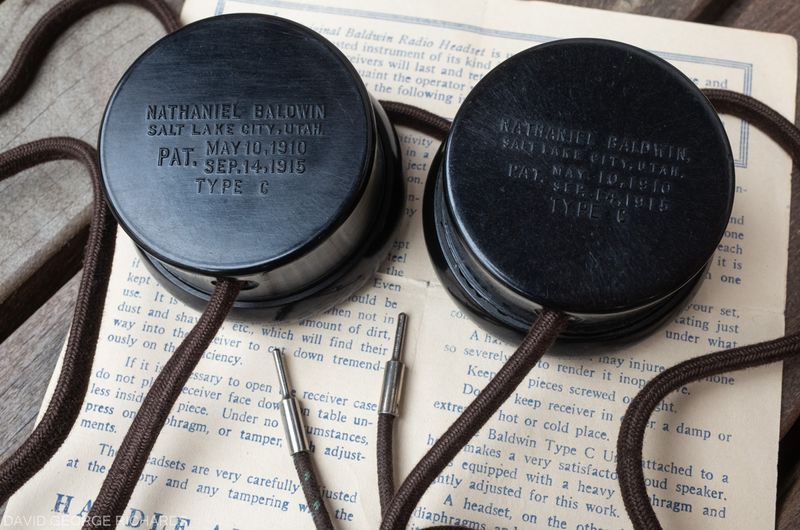
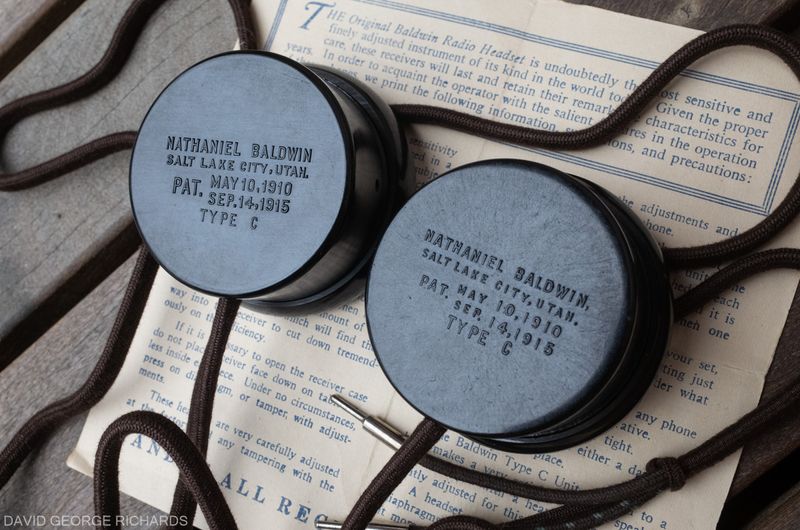
Oh lawdy. The shiny bakelite. That is original factory shine. The beautiful green headband. It’s almost too much for me to bear!
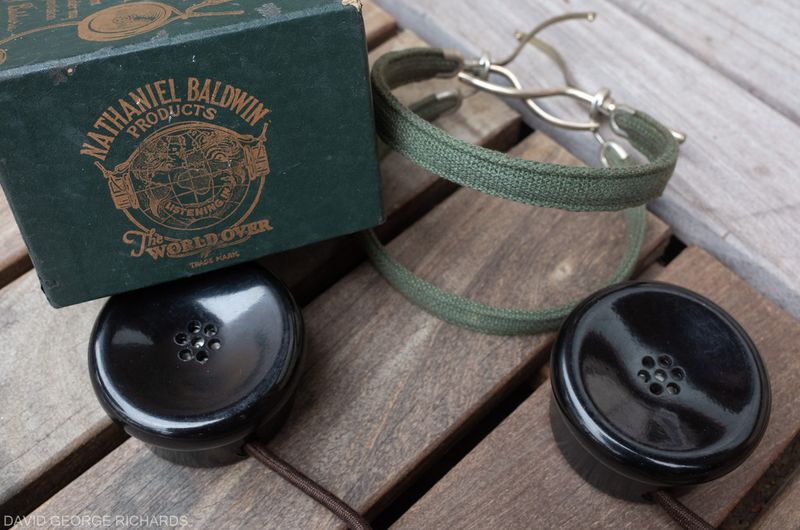
That leaflet, that came in the box with the headset? Here it is –
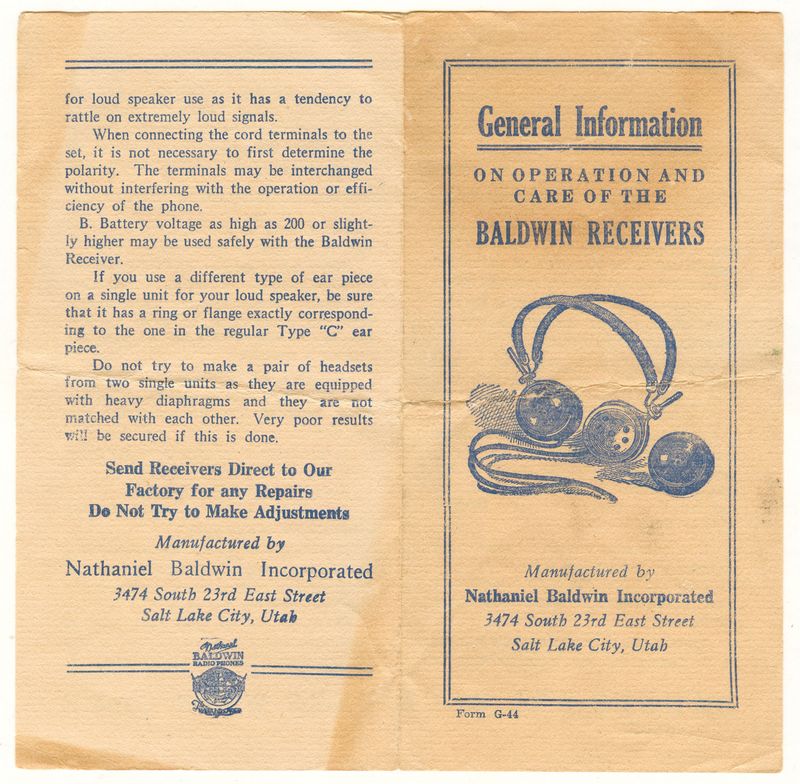

That’s enough of Baldies for now. The other headset of this vintage that I was keen to land a working pair of, was the Western Electric 509-W. Patented in 1918, this headset was also very popular with telegraph and radio operators in the late teens and 1920’s, mainly due to it’s ruggedness and sensitivity. Many believe 509-W’s to be equal to Baldwins due to their sensitivity, robust nature, and quality of manufacture. In the opinion of Scott, from oldheadphones.com, they are ideal for crystal set use, and their performance rival that of Baldwins, only being surpassed by Navy sound-powered headphones.
Continuing my quest to land a bargain, I scored a set of 509-W’s for just $10.50 + $14.85 shipping. They arrived in good, though obviously well used, condition –
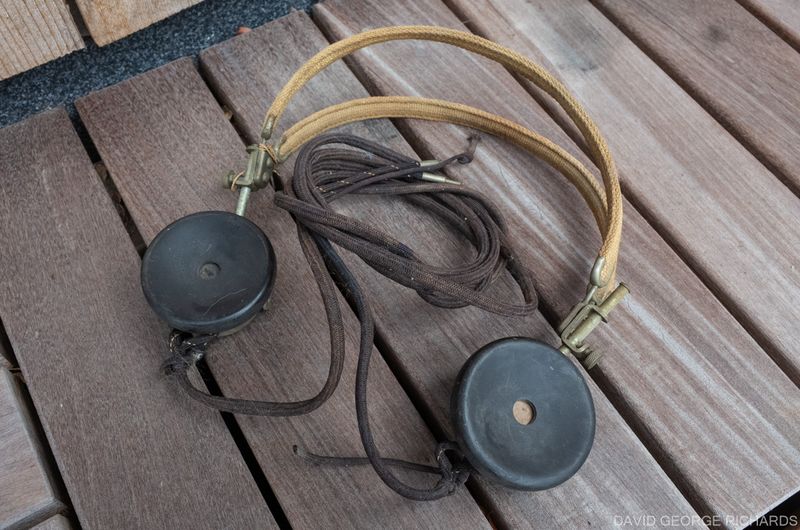
A bit shabby, to be sure. Allow me to show you a few more pictures, before I reveal how they cleaned up –
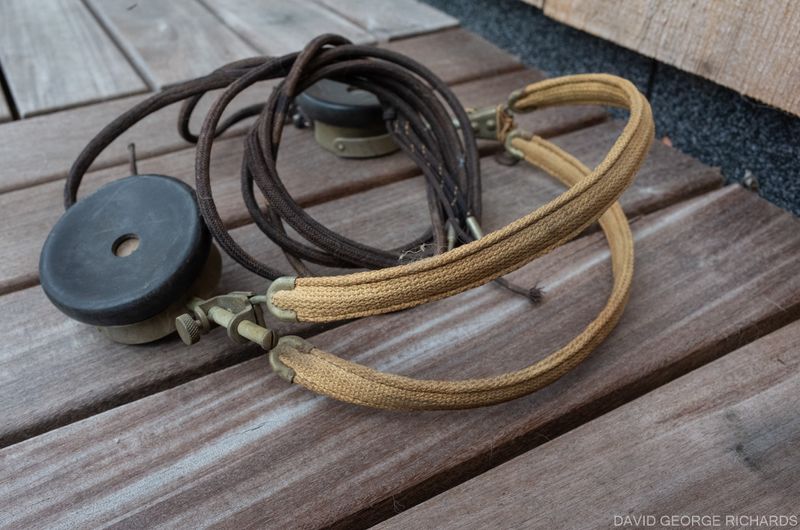
The metal cans were dull, but with no major scratching or other damage. The slots on the two screws that hold the sound element to the nickel-plated brass cans are often knurled or otherwise damaged. Not so in this case, which I took as a good sign –
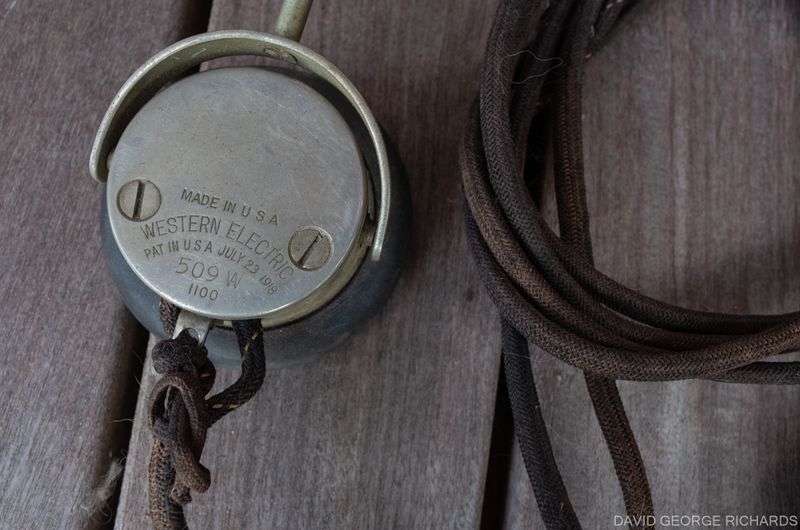
These are not balanced armature units, like the Baldwins. They are the more traditional style, which makes the poles of the magnets very easy to access for the purpose of re-magnetizing, if that becomes necessary. Like the Baldwins, the headset cord is easily attached and attached with 2 screws. The general rule of thumb for determining if the unit needs re-magnetizing, is if the magnet holds the metal diaphragm on, it is strong enough. These headsets are the more traditional type, with both poles exposed, making remagnetizing easier, if necessary. For these traditional types of headsets, of remagnetizing, Scott says, “I just use a strong rare earth magnet and a couple taps on one pole of the weak magnet takes care of it.”
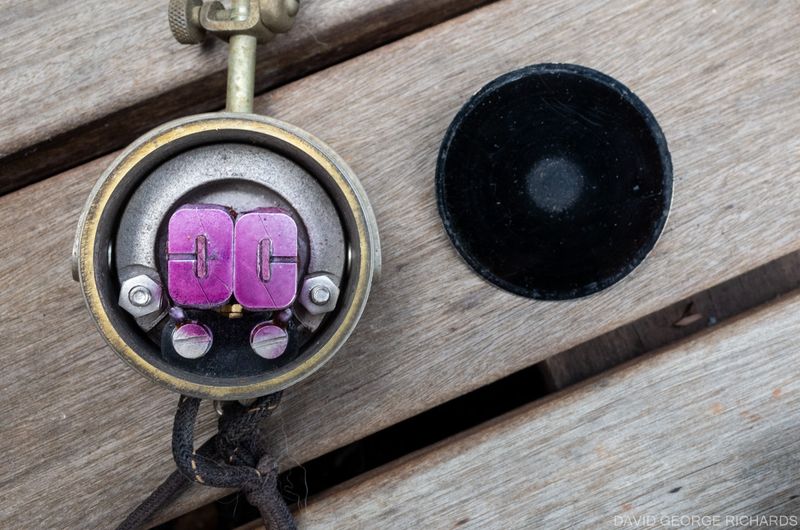
I polished the metal parts with Brasso, washed the bakelite ear caps with Bon Ami, and soaked the headband in cold, soapy water, then lightly scrubbed them and left them to dry overnight. The headphone cord smelled of tobacco and was a bit greasy, so I also soaked it in cold, soapy water (yes, really) and scrubbed it lightly with an old toothbrush. I then patted it down on a towel, gave it an initial drying with a hair dryer, and hung it up to dry thoroughly, on a hot day.
During this initial cleaning, I did lightly polish the metal cans, but didn’t pay too much attention to the other metal parts. For minimal effort, the 509-W’s came out quite well, I think –
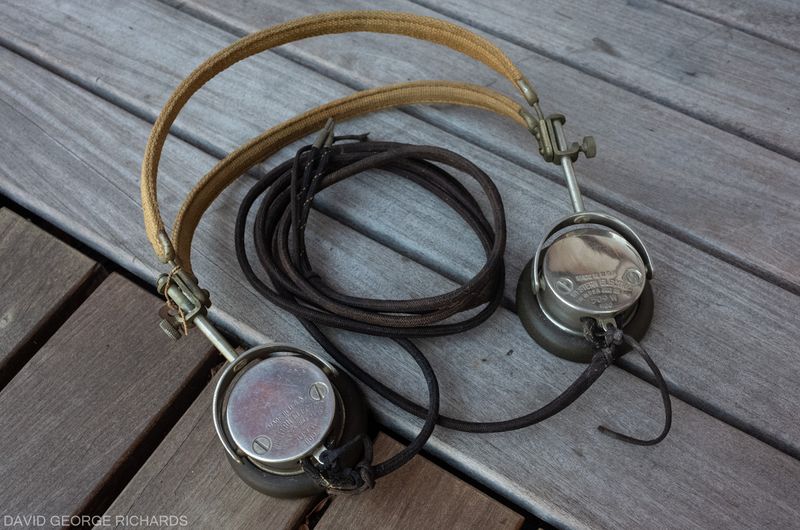
One feature of this set was a little curious. It came with this washer hanging from a piece of string on one side of the headset. To me, it looked as if it belonged there and was an integral part of the unit. I wondered what it was for. I wasn’t able to locate any photos of other instances of this headset with such a washer, and no mentions of a washer anywhere else. After asking a few other 509-W owners, it became apparent that whatever the washer’s purpose was, it was not a stock item, and was not a known 509-W accessory. Eventually, I removed it, but not before taking these pictures. I think the first picture (the very next one) was taken partway through the cleaning process, before all the metal had been cleaned up –
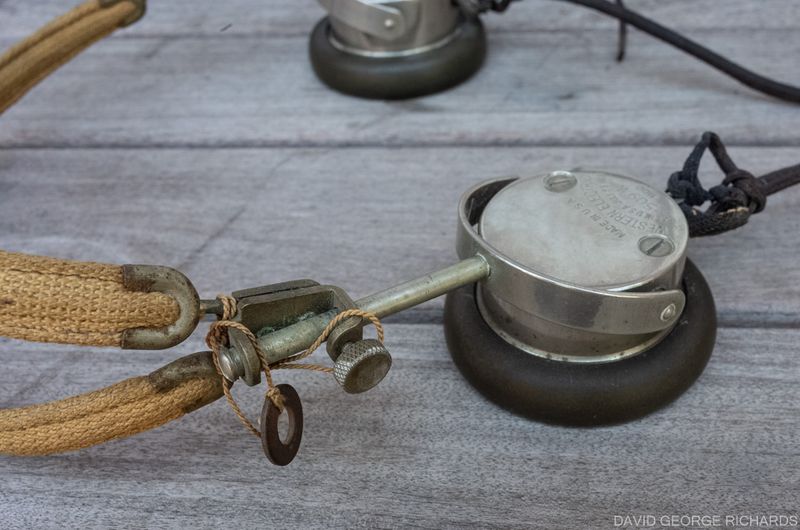
The headband came out a lot cleaner. The cord looked a little better, though the main improvement was that it felt a lot less greasy –
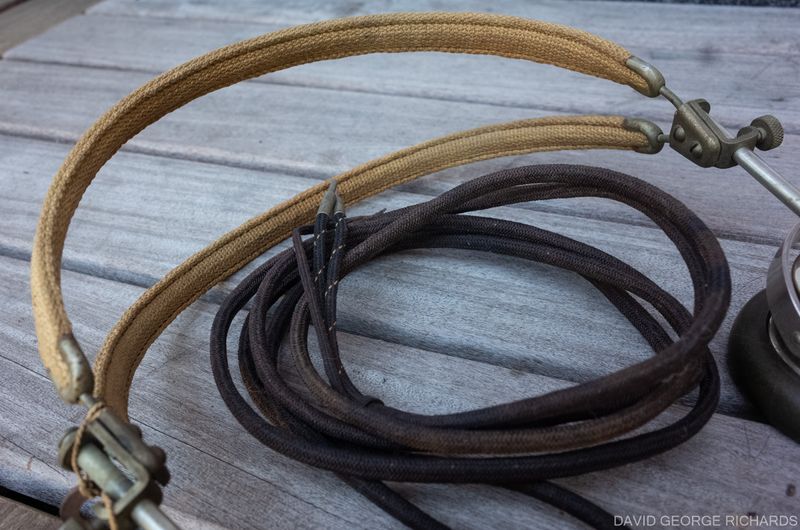
Shiny!
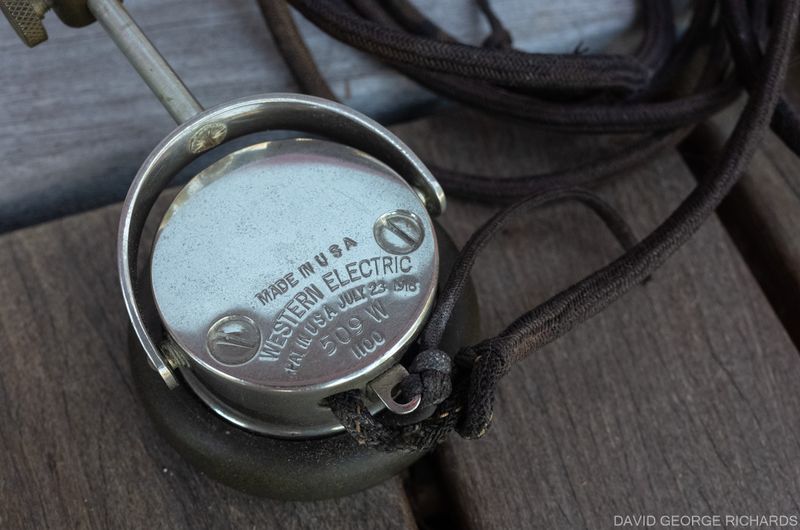
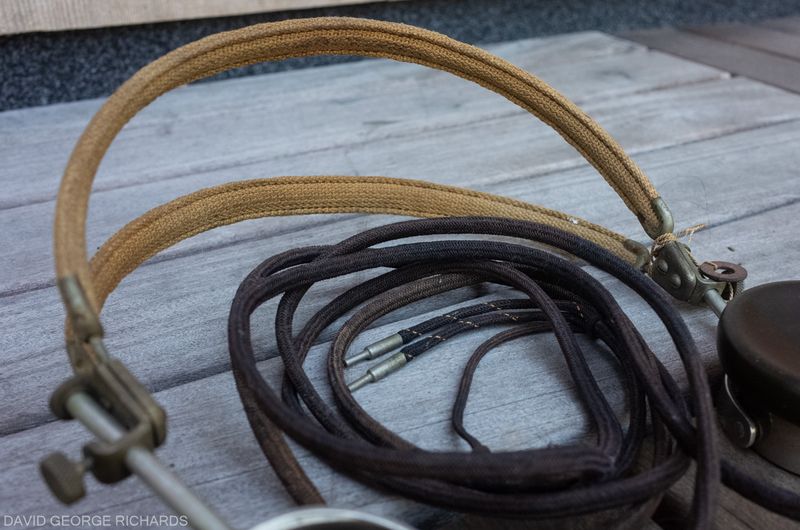
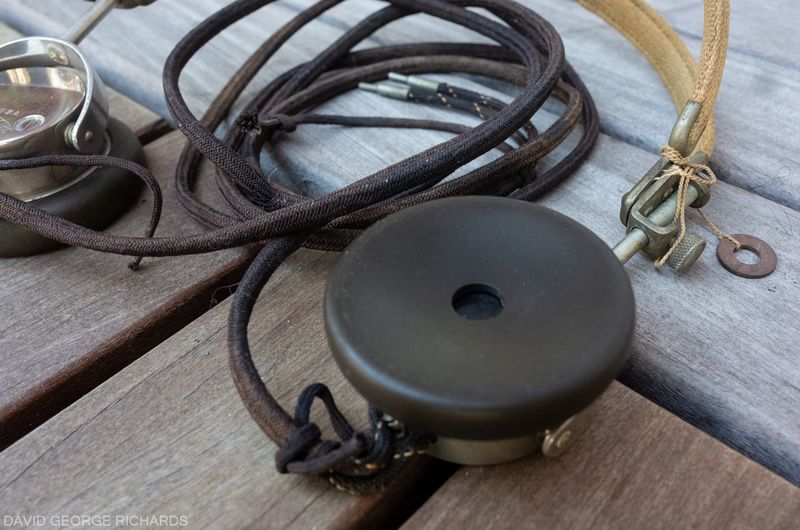
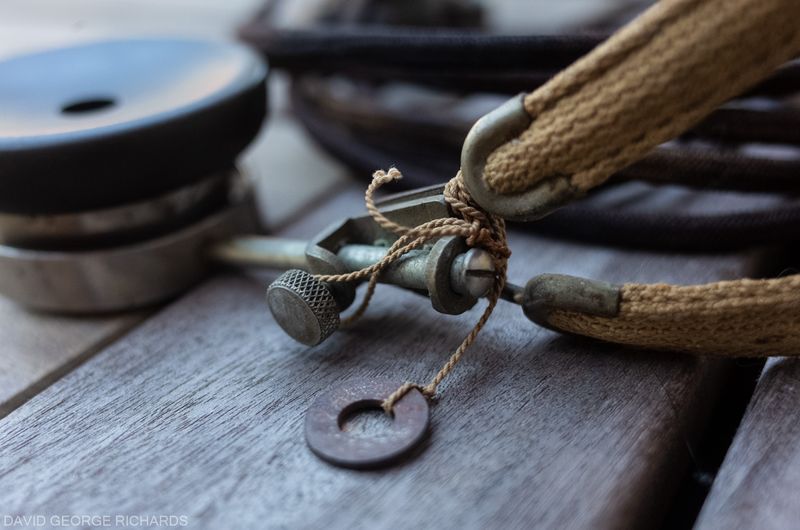
Western Electric 509-W headsets are not hard to find in fairly good, working condition. There are still a lot of them around. They were well made, and cost $12 in the early 1920’s, the equivalent of a week’s wages for the average worker. Other brands of headphones, that were less well-made and not as sensitive, cost less. Brandes were $8, and other brands even less. I wonder how many sets of headphones being used today will still be around 100 years from now and working well?
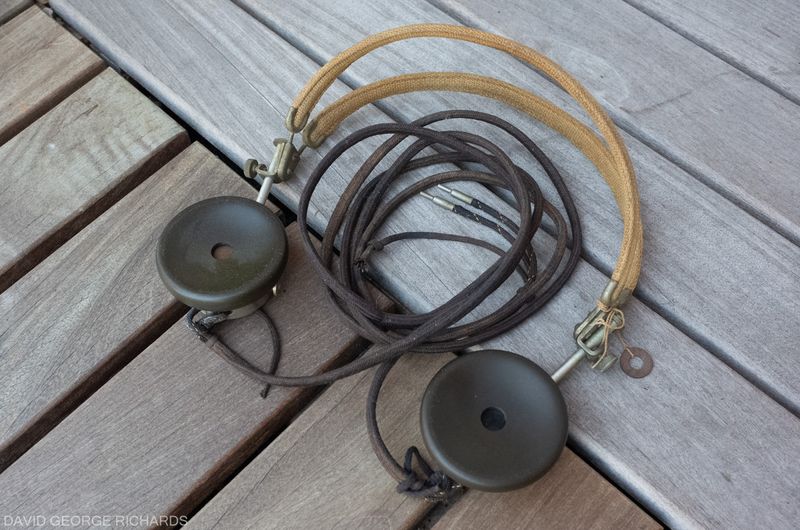
Cloth headset cords of this era came with strips of material on the ends that attached to tabs on the cans for strain relief –
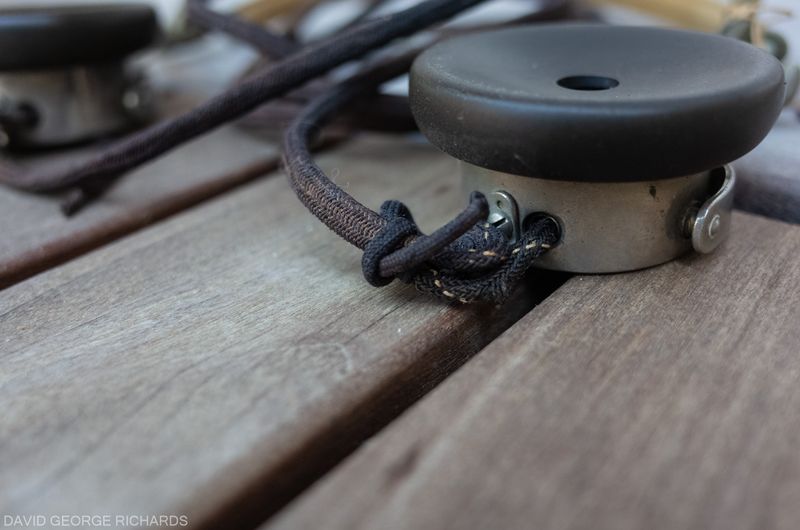
The headband is looking pretty spiffy and clean from this side!
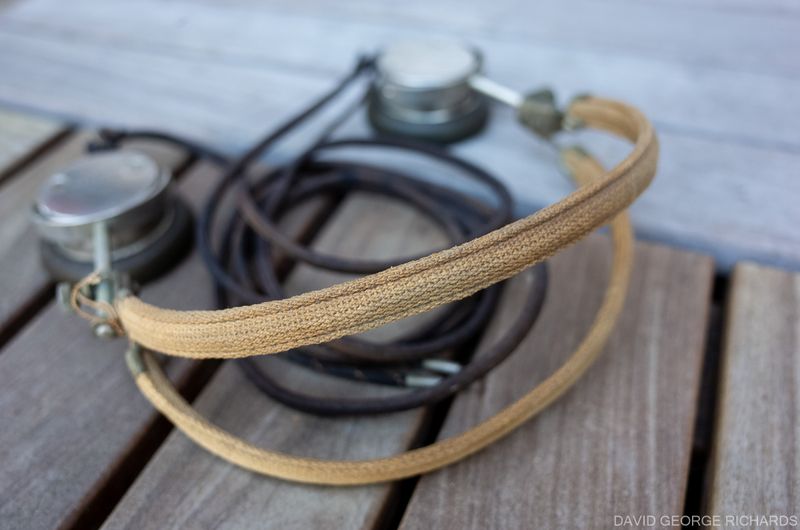
Next on the agenda was to put together a sound-powered headset. Sound-powered units are used by the military; primarily, I believe, by the Navy. The sound elements are so sensitive, you can connect two together and they will operate without the need for outside power i.e. the tiny current produced by talking into the mouthpiece will produce a sound in the earpiece. This very informative page on Darryl Boyd’s website has information on many of the available sound-powered headsets you’re likely to find. Jim Frederick W4LF’s favorite is the WW2 sound-powered headset known as the RCA “Big Cans”, which I believe are also referred to as the US Navy “Deck Talkers” (see linked page in previous sentence). He says that they are hard to find and expensive, but so far ahead of the others that they are worth it.
Some of the sound-powered units, such as the US Navy Deck Talkers, have a headset, so little physical modification will be needed in order to use them. With others, the sound elements are in a telephone-style handset. In this case, you’ll probably want to remove the elements from the handset and install them in a headset of your choosing. This page on Darryl’s site lists the specs of sound elements in the various units, and also notes the handsets that have identical elements used for both microphone and earpiece. This can be useful, as you will only need one handset to make a complete headset. I set about looking for one of these handsets, and managed to come up with this Canadian RCA MI-2215-E model, which has 2 identical sound elements –
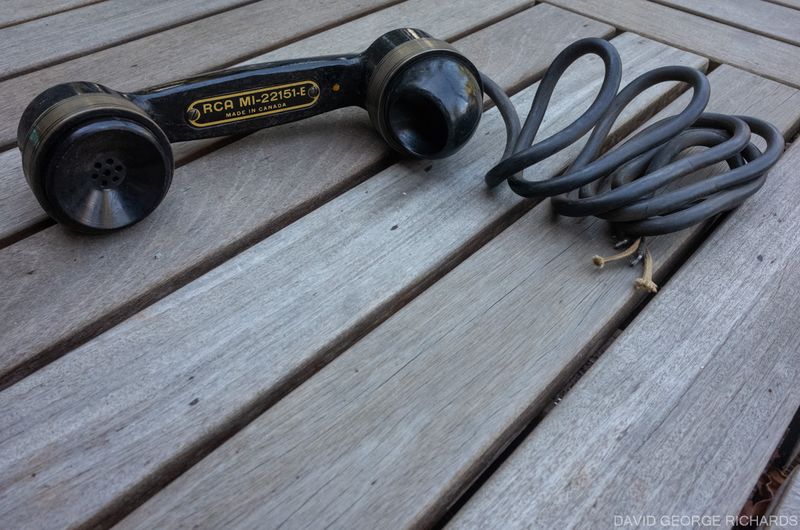
Touching the two leads coming from the handset across the terminals of a AA battery resulted in absolutely no clicking from the headset whatsoever, which was not a very encouraging sign.
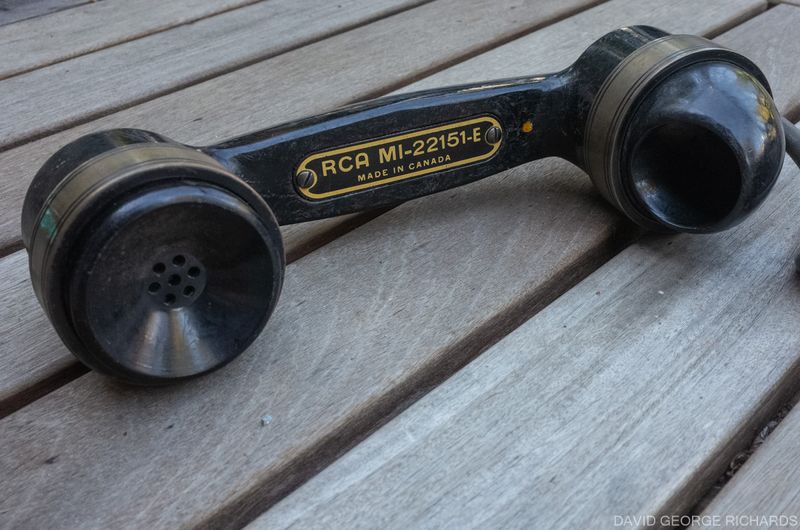
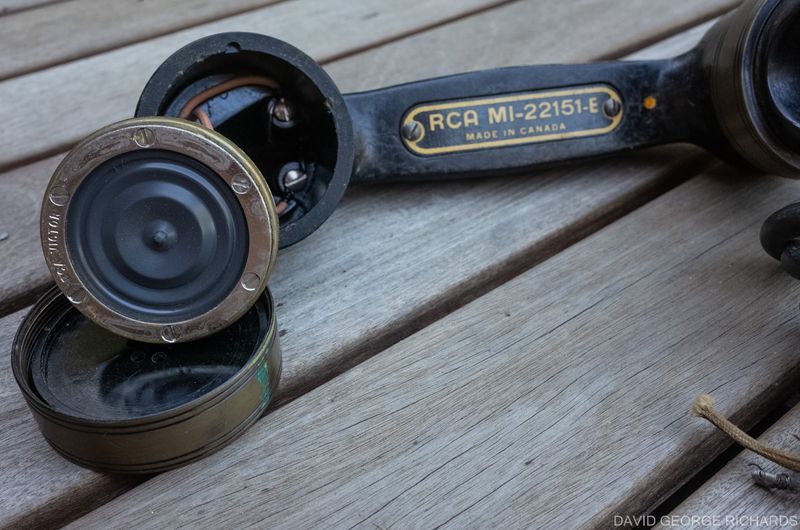
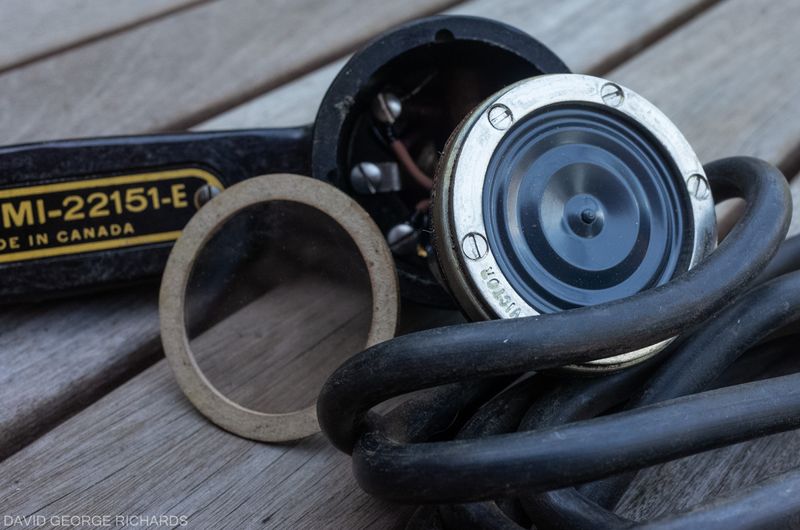
Back view of one of the elements, after the leads had been desoldered, with a strip of tape over the holes to prevent ingress of debris –
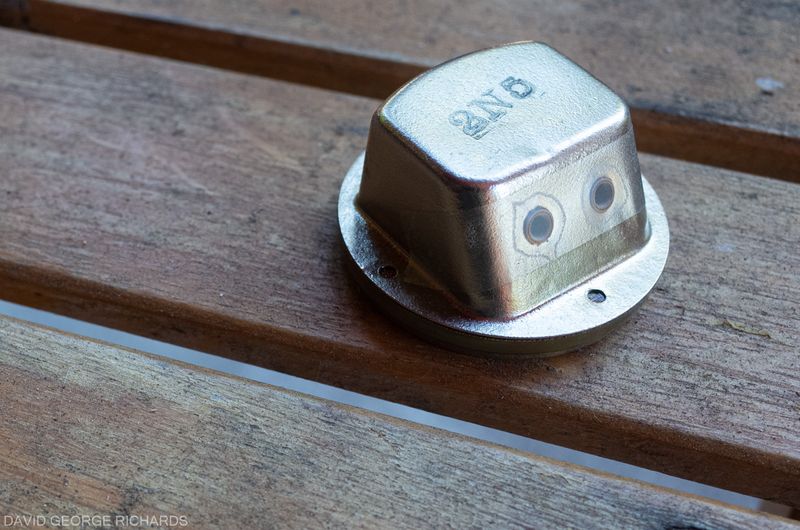
Front view of the same element –
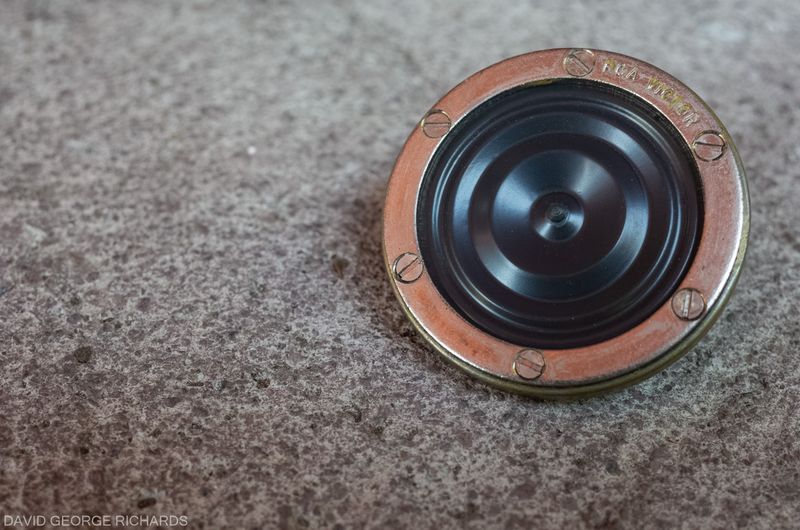
Removing the metal back cover from the first element, the armature plate was clearly visible. If you look closely (easier if you’re viewing this on a computer, as opposed to a phone), the armature plate, which was connected to the threaded drive rod, appeared to be jammed up against one of the poles of the magnet –
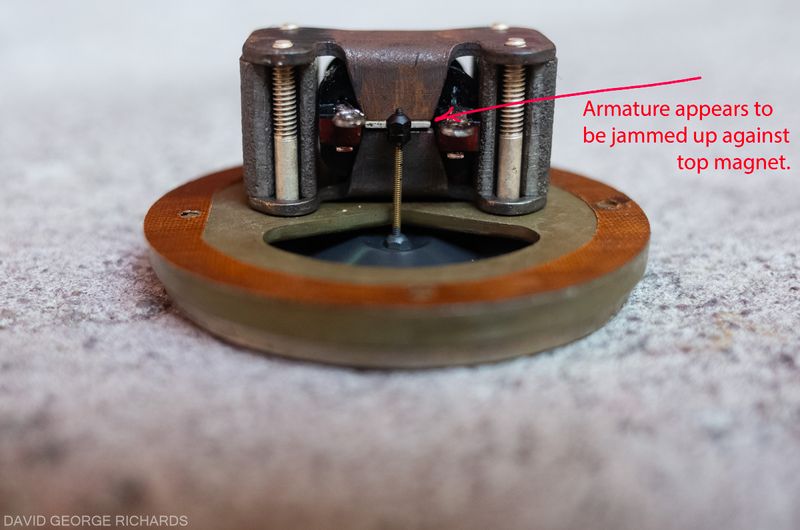
Looking at the threaded drive rod, you may be able to see that there are two small nuts, one above and one below the plate. Adjusting those nuts determines the default positioning of the plate. I adjusted them with a pair of needle-nosed pliers and successfully repositioned the plate halfway between the top and bottom magnet, so it was no longer in contact with the top magnet. At this point, I didn’t have a crystal set to test it out with (I hadn’t yet built the beta kit in my last post). Instead, I connected it to the output of my impedance matchbox, with the output impedance set to somewhere in the region of 300 ohms (the impedance of this element), connected a longwire antenna and ground to the two input terminals of the matchbox, and connected a 1N34A diode across the input terminals of the matchbox. Success, as the sound of a cacophony of MW AM stations sprang forth from the sound element. It was working!
Buoyed by this success, I set about tightening the nuts, and disaster struck. I overtightened one nut, and snapped the very delicate threaded drive rod. I had lost sight of the fact that it is a thin rod. Unfortunately, the break occurred right next to the nuts. If it had been further away from the nuts, I might have been able to solder or epoxy the rod pieces back together. As the break was up against one of the nuts, repairing it would have reduced my ability to adjust the positioning of the nuts on the rod.
Back to the drawing board and, before long, I acquired this H-203/U handset, manufactured by the Dynalec Corporation. This handset has a push-to-talk button –
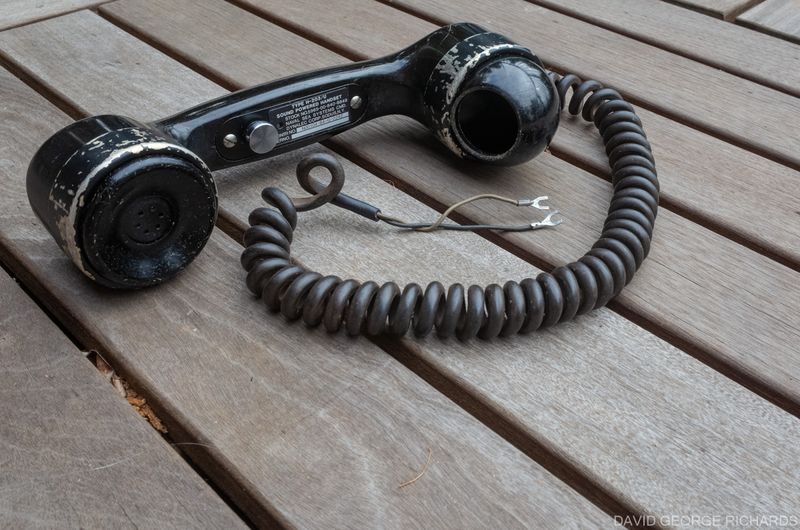
When this handset is connected to another handset, pushing the PTT button connects the handset to the other handset so that, when the PTT is not pressed, the other station cannot hear what you are saying. If you connect the two handset leads together and talk into the microphone, you should be able to hear your own voice in the earpiece. If you’re unsure whether you’re hearing your own voice via the earpiece or via bone conduction, alternately pressing and releasing the PTT while talking will clarify.
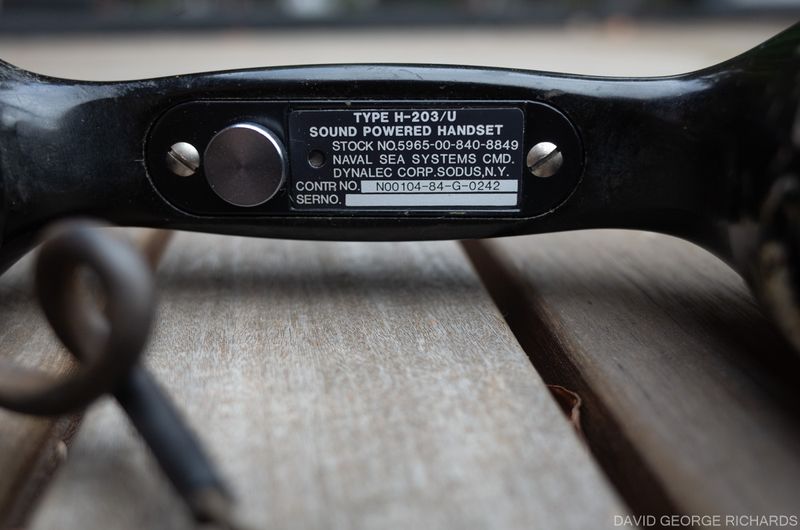
Unlike the previous handset, the identical microphone and earpiece are not soldered in, so it is easy to remove them. They just pull out, revealing the neatly-wired supporting circuitry –
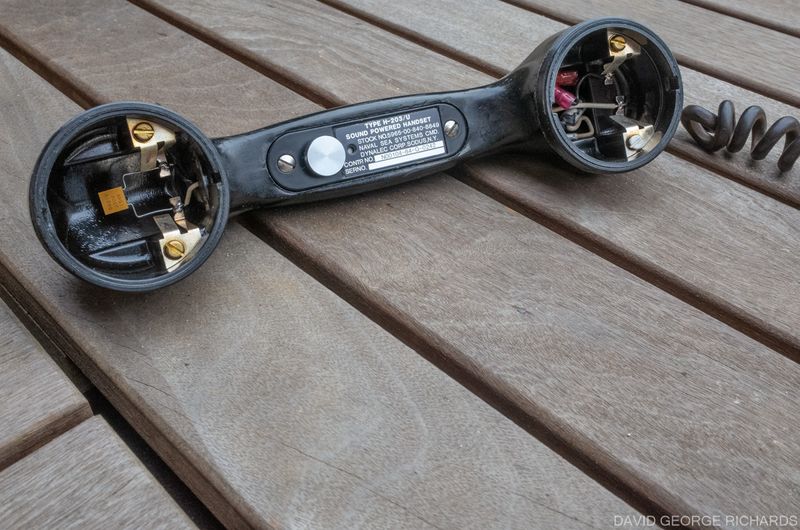
Even the capacitor leads across the earpiece have been neatly preformed. I very much approve!
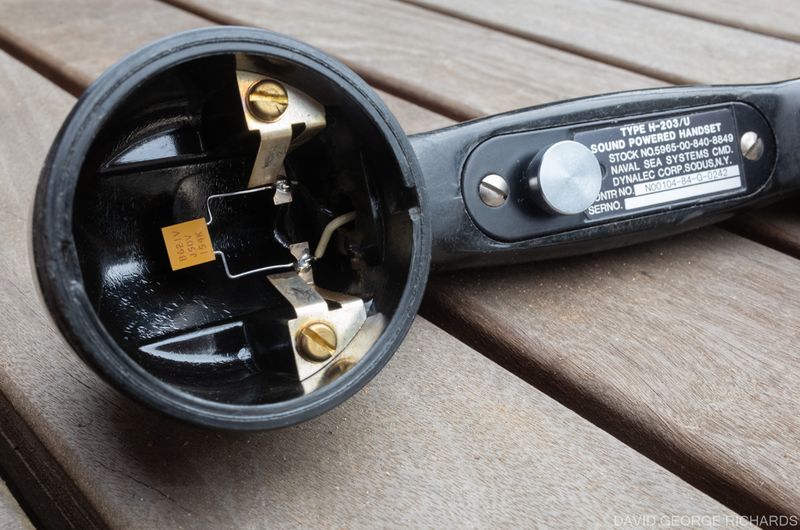
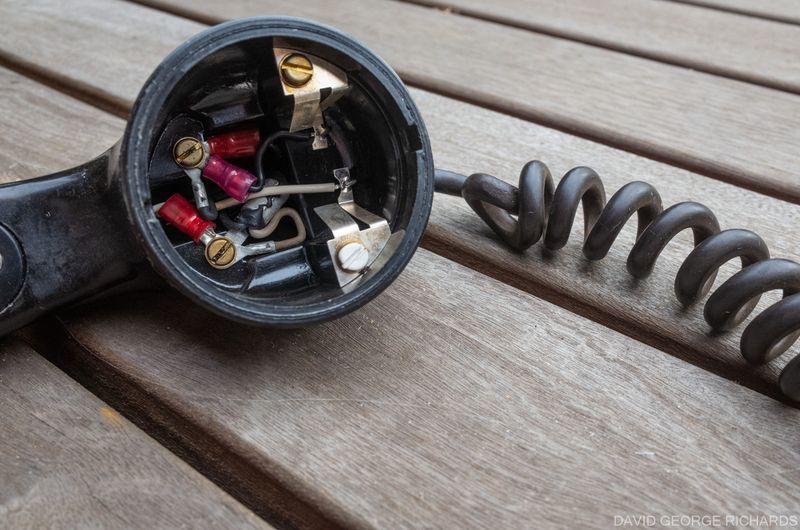
These are the identical sound elements from this handset –

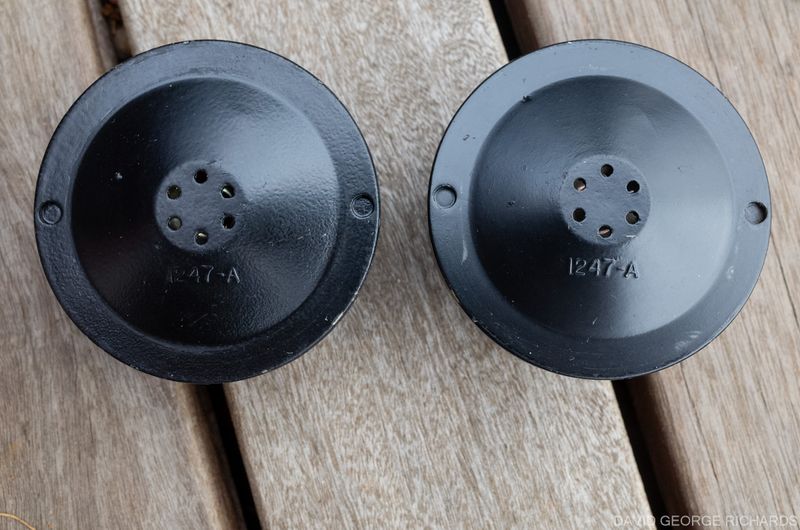
The terminals are easily soldered to, though you have to be careful to apply the iron for the absolute minimum of time, so as not to melt the plastic. I used a little flux from a flux pen, to help things along –
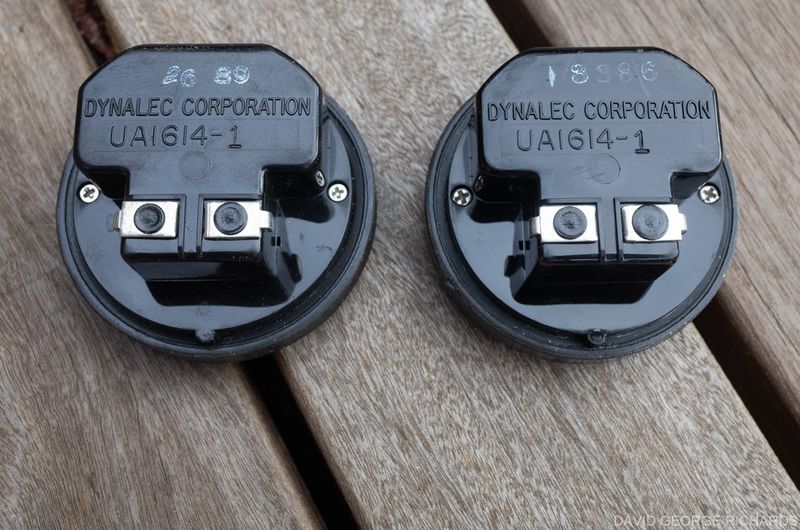
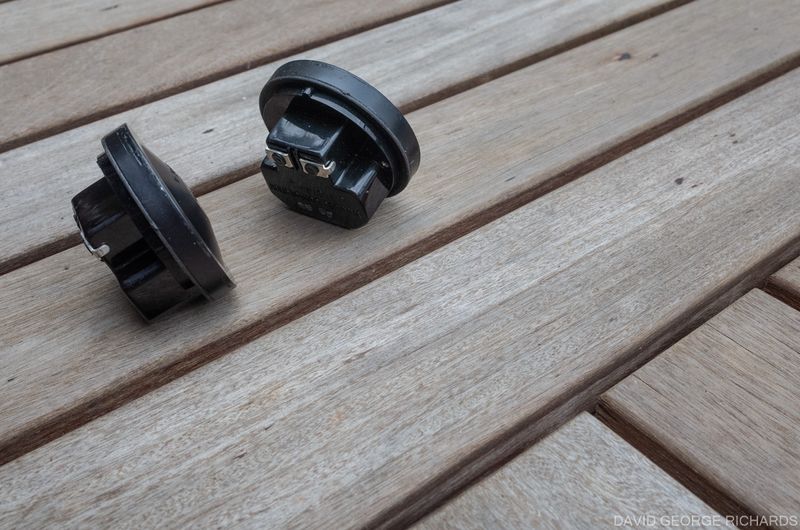
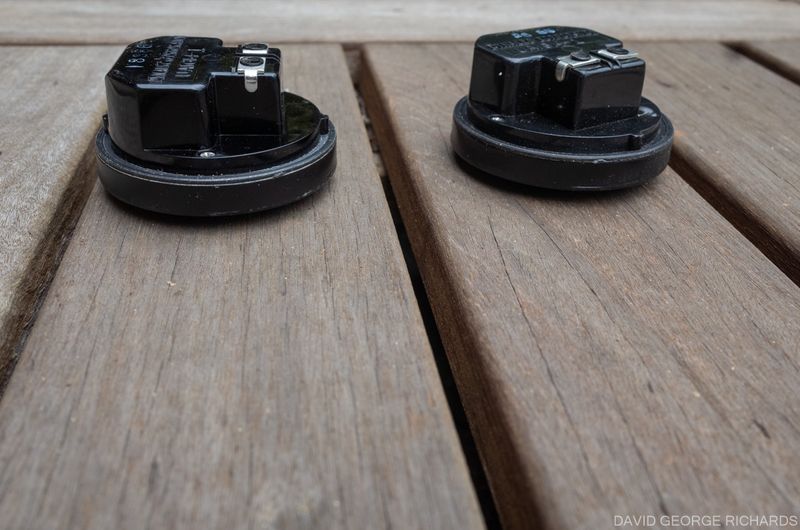

Next on the agenda was to find a suitable headset or old pair of headphones to install these elements in. I found this new unused pair of earmuffs on Facebook Marketplace for $5 –
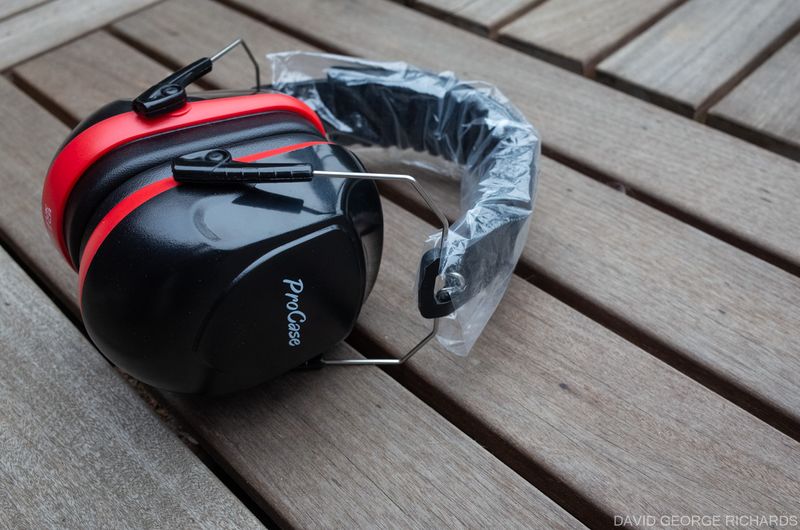
This set of earmuffs turned out to be well suited for these sound elements. The aperture in one end of each side of the earmuffs is very slightly wider, and there is a good thickness of foam lining the back of the earmuff –
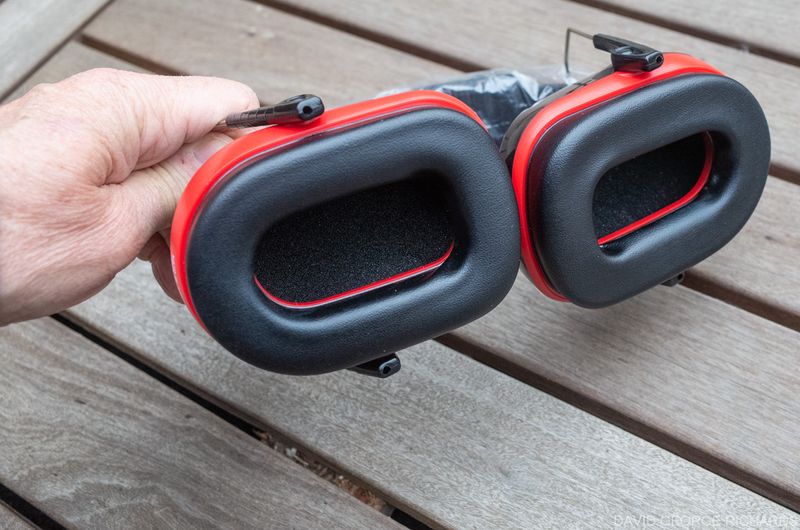
It was possible to push each sound element in at an angle, such that it ended up being held firmly in place by being pressed up against the ledge/flange around the opening, by the foam in the back –
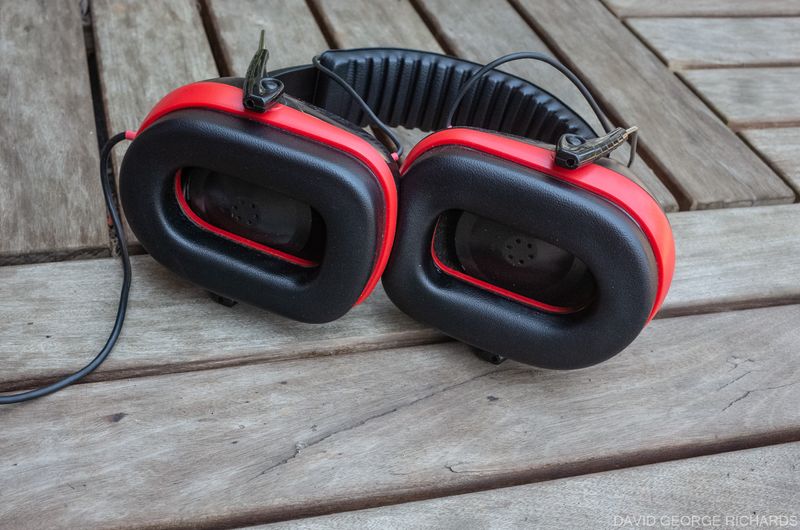
The headset lead enters one side, at the bottom of the can. Heat-shrink tubing over the lead and tie-wraps on the inside and outside of the can hold the lead in place –
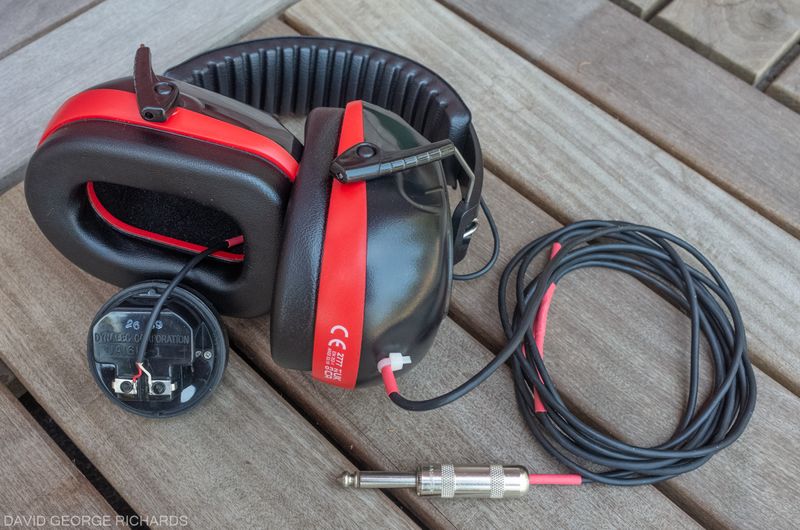
A lead runs in between the cans to connect the elements in series (in phase). It runs between the tops of the cans, underneath the cushioned piece that surrounds the headband –
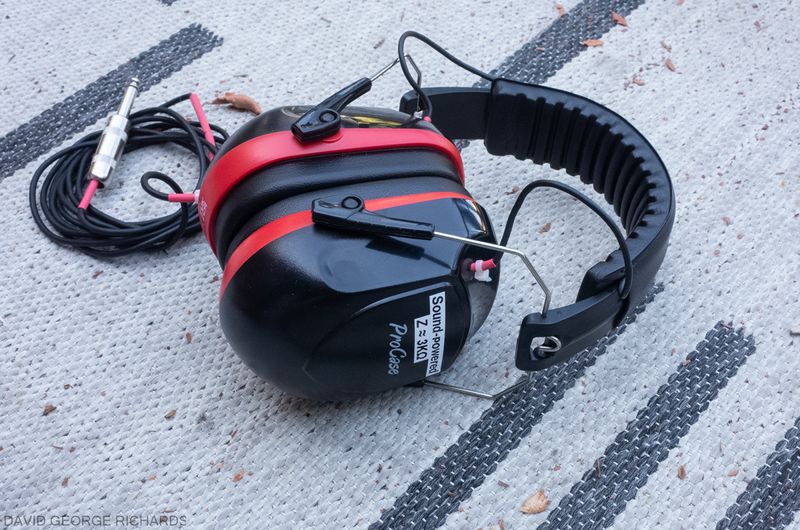
These ProCase brand earmuffs are available on Amazon at the time of writing for $16.99, although the FB Marketplace price of $5 from a local private seller was a no-brainer, of course. The only possible drawback to them is that the fit is very tight, though as the purpose of earmuffs is to keep ambient noise out, this is an intentional part of the design. One could argue that a sound-powered headset will only be worn for the very weak DX stations, and the absence of outside ambient noise is helpful when trying to copy them. I used an old headphone lead from a pair of AKG 240’s with the molded plug at each end chopped off, but you can use anything that works for you.
Also included in the assortment of headsets/headphones/earbuds/earpieces that I tested with my newly built crystal set and impedance matchbox, was a classic piezo earpiece, often known as a crystal earphone. The styling hasn’t changed over the years, and many of the cheaper crystal radios marketed to youngsters in the past, such as the rocket ship crystal radio, came with one of these. The metal diaphragm is connected to one of the leads, and used to be soldered to it. In recent years, many of the units sold had a foil diaphragm with the lead held to it partially by glue and partially by the pressure of the plastic case against the lead. As a result, there was a high rate of failure. Both the piezo earpieces of this type that I bought failed soon after I acquired them. However, the old-style with a soldered connection are still available. Mike’s Electronics sells them. There is also a seller on eBay called protechtrader who sells them (they recently increased the price significantly, from $10.70 to $14.99, both prices including shipping). The earpieces from the eBay seller have a characteristic black lead and plug. You can see the brass color of the diaphragm too, which I assume is also the case with the one from Mike’s –
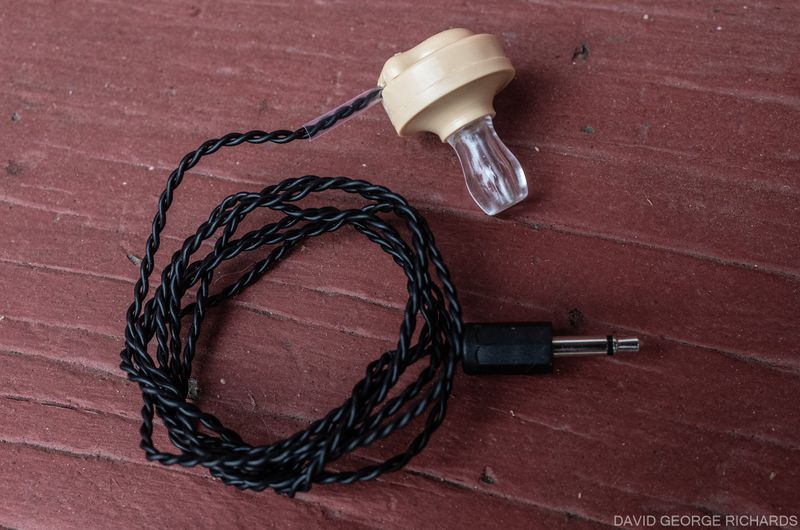
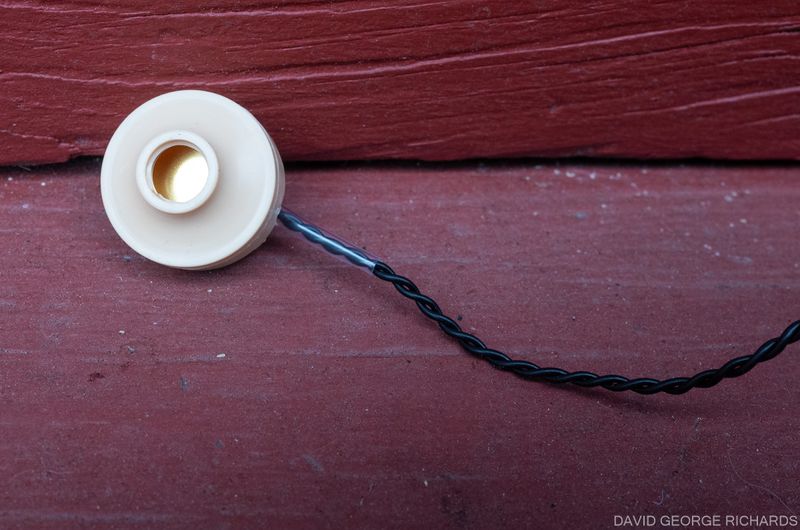
These piezo earpieces have a 3.5mm mono plug. The 3.5mm jack on my impedance matchbox is wired to a stereo plug, so a 3.5mm stereo male to mono female adapter was pressed into service.
Also tested were an MDR-W14 yellow headset from an old Sports Sony Walkman cassette player/ AM/FM radio combination, and a pair of C Crane earbuds, both low impedance –
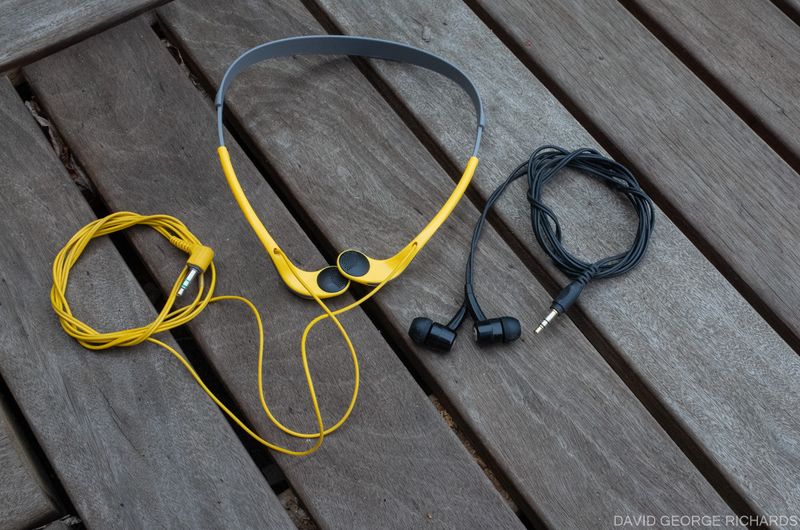
I forgot. I also tested my beloved AKG 240’s, of which I own 2 pairs. I used these for years, when working as a DJ/announcer, and voiceover guy in Los Angeles. I also use them with my Elecraft K2 on CW, as they are very comfortable to wear for long periods. I wasn’t expecting a lot from them for crystal set use though, as they are known for not being as sensitive as the more consumer type low impedance models. They are intended mainly to be driven by the headphone amplifiers present on mixing boards and similar professional equipment, which is capable of providing a greater drive level than the amplifiers in small consumer products such as Walkmans/radios/MP3 players etc –
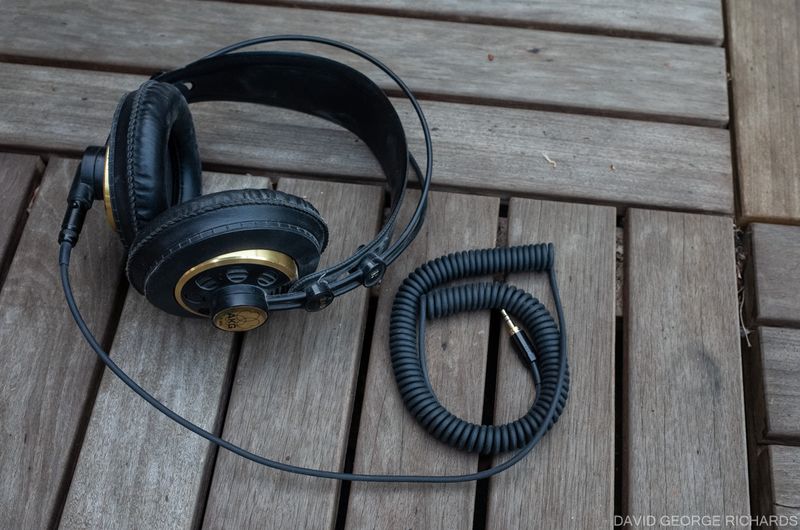
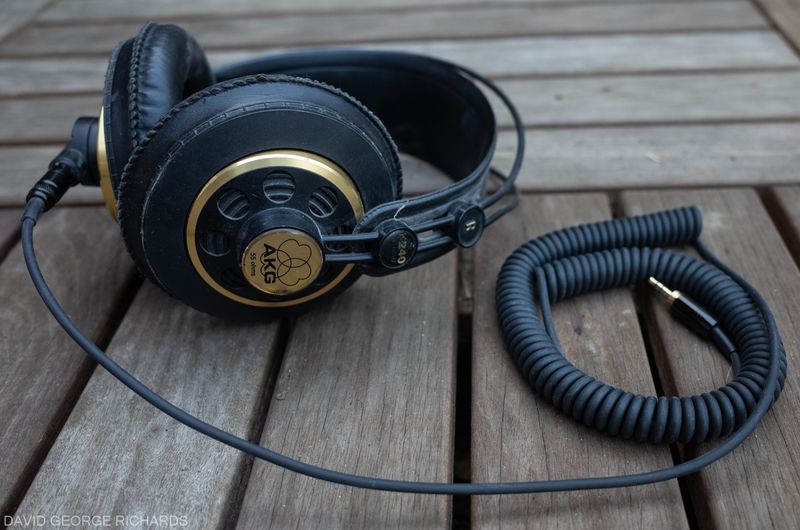
OK, the big test. How do all these different headsets/headphones/earpieces/earbuds stack up against each other? Firstly, allow me to say that I haven’t yet performed extensive testing with many very weak stations, so take these preliminary results with a pinch of salt. Also, at this point, I still have some significant improvements to make to my antenna, by lengthening the outside portion of it from 45 feet to about 75 feet. This will very possibly yield a far more noticeable improvement than which headset I choose to use will.
That said, here are my initial impressions.
As expected, the AKG 240’s are the least sensitive, though not by as large a margin as I expected. They was, at a rough guess, about a 6 dB difference between them and most of the other headsets which, surprisingly, all seemed to be roughly the same in sensitivity. However, the AKG’s have a wonderfully flat audio response, and AM radio sounds great on them. They’re really good for listening to stations that are moderately strong, or greater.
The piezo earpiece was sensitive, though the sound was very restricted and tinny and, because it’s just one earpiece as opposed to two, doesn’t sound as loud as the other units as it’s only in one ear. Wiring two in series or parallel might help with volume, though the frequency response will still be very tinny. Plus, it kept falling out of my ear, which was annoying.
The Baldwin Type C, Western Electric 509-W, homemade sound-powered headset, Sony Walkman MDR-W14 headset, and C Crane earbuds all seemed to be quite sensitive, about as sensitive as each other, and about the same volume on weak to moderate strength signals. On strong signals, the Baldwins and sound-powered headset weren’t quite as loud as the others due, presumably, to the physical limitations imposed by the balanced armatures.
My initial impression was that, if anything, the Sony Walkman MDR-W14 headset was very slightly more sensitive than any of the others tested here. However, I’m not sure if that’s really the case, or has more to do with the fact that sound is transferred more efficiently to the ear because of the way that the headset earpieces sit in the ear canal. Being earbuds, the C Cranes also sit in the ear canal, but the Sony headset has a slight edge over them. However, I believe this is mainly because the Sony set has more response over the whole audible frequency range, while the C Crane earbuds purposely have their frequency response shaped to favor voice, with a sharp drop-off above about 7-8KHz.
The Baldwins and Western Electric 509-W’s both have somewhat restricted frequency response; the WE’s have slightly more bottom end.
Both the C Crane earbuds and Sony MDR-W14 headset sound a lot louder on strong signals, yet are also sensitive on weak signals. Of the two, the Sony has the widest frequency response. For most types of listening, my favorite headset, of all of them, is the Sony. My sense is that it would also be good for listening for weak DX stations. It’s possible that a headset with less bottom end might increase intelligibility and copy on the very weakest of stations. It’s for this reason that I’m thinking it’s worth keeping several headsets to hand, just as many serious listeners keep a selection of diode detectors on hand, for the most challenging of DX catches. Interestingly, my initial take on these headsets aligns with what Al Klase has said, namely that in his experience, modern earbuds, even the cheap ones, are about as sensitive as sound-powered headsets.
I find all of this a bit frustrating, because I went to quite a lot of expense, time, and trouble, only to discover that my favorite headset to listen to my new crystal set on, was a cheap Sony Walkman model that I already owned! I am not too surprised by this finding, as I had already read Al’s remarks, but needed to find out for myself. I could have saved myself quite a lot of money. On the other hand, I do enjoy owning a few pairs of vintage and antique headphones. The Baldwins and WE 509-W’s both occupy significant places in radio headset history, and my mint Baldies are museum grade. There’s a definite pride of ownership at play here.
Bear in mind that with vintage headsets, there can be variation in their performance, especially if they’ve been treated poorly throughout their long life. Sound-powered headsets often received rough treatment while in service. If you have a set that are in poor physical shape, they may have received a lot of knocks during their life that degraded their performance. In other words, my very brief test drive of these different sound-producing devices was preliminary at best. Nevertheless, things are looking good for the combination of matching transformer and a modern headset/earbuds using neodymium disc magnets and lightweight components.
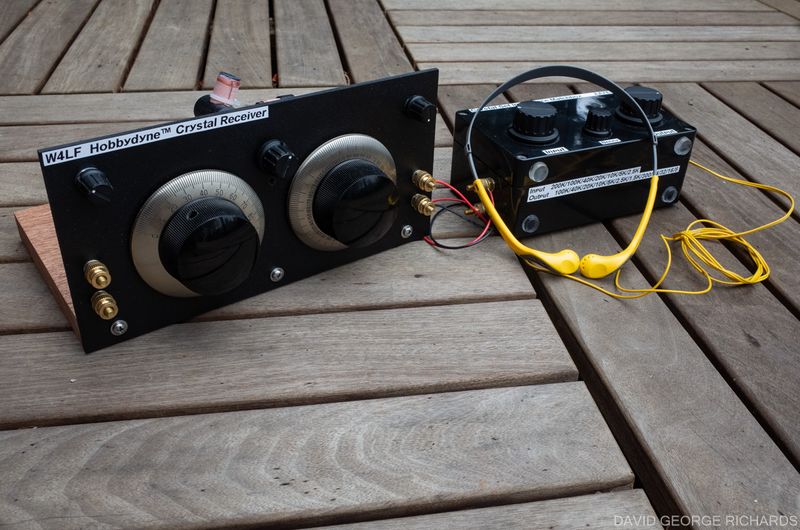
It turns out, after all those vintage headsets, and a homebuilt one, that my favorite way to listen to this crackin’ little crystal set is on a pair of Sony Walkman MDR-W14 headphones. They have great fidelity, are the loudest on strong stations, and appear to be sensitive as well. I do wonder if a pair of US Navy Decktalkers (the famed RCA “Big Cans”) would beat them on very weak signals, but Al Klase appears to have a pair of those, and still said that modern earbuds are about as sensitive as anything else he has used. Who’d have thought! Crystal set enthusiasts – what are your experiences?


An encyclopedic post on headphones from the golden age of wireless to (almost) today. Thoroughly enjoyable.
I regularly saw what we used to call ‘old wartime phones’ almost identical to the Baldies lying around ham shacks in my youth in the 70s, and at one point I think I owned a pair, as I remember unscrewing the earpiece assembly and gawking at the electromagnetic innards. They are long gone.
I suspect they were an Antipodeian copy of the US models. In Australia the Post Master General’s Department (PMG) consumed a volume of wireless and Telco hardware, mostly locally made. Amalgamated Wireless Australasia (AWA) famously made military and consumer radio products and may have made something similar. There may be other Aussie readers who can provide more detail.
My audiophile cans are Audiotechnica, purchased about 5 tears back. Insensitive for radio use but flat and great for audio. I bought them for checking the audio when making videos!
73 Paul VK3HN.
Thanks Paul. I wanted to try out a variety of different types of ‘phones, though I’m coming to the conclusion that I suspected I would – that the new gear works pretty dang well! There is a great value to ‘phones with a flat response, IMO. My AKG 240’s are like your Audio-Technica’s in that respect. I prefer them to the more consumer-oriented models that emphasize the bass.
As sensitive as some of the older headsets are, I tend to wonder if some crystal set enthusiasts are swayed by what one might call the “vintage aesthetic” in their assessment of the performance of the older units.
Thanks for the post which spurred me on and rekindled an interest in crystal sets, natural diodes and earphones. Years ago I made an earphone by winding my own coils on a hundred year old lathe and using magnetised iron nails. It worked but wasn’t an outstanding achievement. So last night I went back to a couple of 1920 – 30s, high impedence earphones, that claimed to be 2KOhm, that were hanging on the shack wall. One, all alumini(u)m, ‘Pacent’ set only worked on one earpiece while the vulcanised rubber cover on the other set was crumbling to bits. Examination of the Pacent set showed that the windings on one of the magnet coils had detached from the binding post and thus continuity had been lost. I didn’t measure the diameter of the magnet wire but it made a human hair look coarse but undaunted I gently stroked a scalpel blade along the wire to expose the copper and micro soldered the end back onto the post. Abject failure – still no continuity, probably the coil was discontinuous within anyway. But it occurred to me that maybe I could bypass the dodgy coil and take the end of the good coil directly to the binding post. More micro soldering (soddering?) and it worked. The series impedence of the two earpieces is 3KOhm. And that’s OK My interest has also been in using ‘natural’ diode materials. In a former life I used to call on the makers of Silicon Carbide (Sic) abrasives and scored some chunks of Sic. I’m going to set up a pea sized bit into a molten lead cup which as it cools should made a good electrical contact (particularly if I can get the lead to form around copper contact strip). The Sic should easily handle the temperatures without deterioration (we used to use it as muffle walls in ceramic kilns). I also have some chunks of Galena which will be another source of experimentation. (Don’t know how that will handle hot lead though as I have a nasty feeling it will break down to Lead and Sulphur dioxide. Sorry for the long email. I’ll keep you posted Tony VK3TP
Best of luck with your experiments Tony, and I’m happy to have helped rekindle the interest. Congratulations on getting those Pacent ‘phones working again. I wonder how bypassing one of the coils has affected the sensitivity?
Here’s to many happy hours of experimenting!
73 for now,
Dave
AA7EE
That’s an interesting post. I hadn’t thought about differences between those old style headphones. I have an old pair of STC headphones. What they lack in performance they sure make up for in weight. I never found them to be any good for much. After reading your post I removed a cover and each side is simply two electromagnets with a round piece of sheet metal held just above the electromagnets. It’s not surprising they were never very good.
The most pleasant I’ve had were a pair of 1980’s Pioneer SE-11 headphones. These were very sensitive and had a resistance of about 600 ohms per side. I found they worked well without a transformer, but I only ever received one station. I didn’t think about how a low impedance would affect selectivity and being rural with only one station in the are I guess that was ok. Interesting to see that it turned out to be a more modern pair that ended up being your preference, but those old ones do look good.
My Western Electric 509-W’s are about 100 years old Garry (maybe a little less). They, like your STC’s, consist of two electromagnets on each side, with a metal diaphragm on top. However, they are quite sensitive. Their main drawbacks, compared to their modern counterparts, is that they are not as comfortable to wear, and the frequency response is restricted. Baldwins and the 509-W’s and similar units, cost significantly more than many other models at the time. From what I have read, the performance was often reflected in the price. Nowadays, sensitivity in headphones and earbuds is easy to achieve but back then, you had to pay for it.
If those Pioneer SE-11’s had a DC resistance of 600Ω per side, the impedance was probably several times that, meaning they should have worked quite well with crystal sets, as long as the sensitivity was good enough.
Yes, although the modern headphones and earbuds are comfortable and seem to perform well, it’s hard to beat the vintage aesthetic!
Ahh incredible post! Those 1915 – 1918 earphones are gorgeous.
I remembered my old English teacher (a radio ham who initiates me in radio) got a pair
of these kind.
Cheers from Argentina Dave
They’re really good-looking aren’t they? So good looking that I may never use them!
Greetings from California, USA to Argentina!
73 for now,
Dave
AA7EE
Great article Dave ! I read it all and was late for work. In the late 60’s I had a pair of headphones from Lafayette which I used with my HA-230 shortwave receiver and they also worked with my homebuilt crystal set. Best I can remember they were advertised as 2000 ohm. They were about $5 when I bought them. They seemed to be of reasonable quality and performance but not quite as historical as the some of the units you tested.
In the 70’s at a military surplus auction I bought a case of WWII vintage headphones which were still in the original DOD packaging (sorry, I don’t remember the manufacturer or model number). I did try a pair of these with a military field strength meter bought at the same auction. With the FS meter connected to my 40 meter ground plane I was able to hear many shortwave broadcast stations as I tuned the meter across the several HF bands which it covered. I was very surprised at the performance of the meter/phones combination. I took the case of phones to the Dayton Hamvention flea market and they were sold out in no time.
Off the subject somewhat but I would like to ask you and your readers about a Heathkit crystal radio kit which my aunt gave to me as a Christmas present when I was about 12 years old. This would have been about 1964. I have long since lost the little radio but I still have fond memories. It wasn’t the Heathkit CR-1 which I have seen much about on the internet. Interestingly I have seen absolutely nothing on the Heath set that I had. This kit was housed in a very nice metal cabinet about 2″ tall by about 4″ wide and 4″ or so deep. As I recall the cabinet cover was an attractive brown color with a creme colored panel, black lettering and a “Drake style” bar knob to tune the very high quality 365 pf variable capacitor. It came with a crystal earphone Iike my “Rocket” crystal set and used fahnstock clips for antenna, ground and earphone connections. The tank coil was a loopstick with a 1N34 diode for the detector. The most unique feature was a PCB which had holes for screws and nuts which were used for connecting component leads to the board, no soldering required. The unit was very attractive and performed very well listening to our local AM station, WWXL with 1KW on 1450 KHz which was only about 1/2 mile from our home.
Since I haven’t seen any picture or reference to this Heathkit crystal set on the internet I assume it was made in limited numbers. Any feedback is appreciated.
Sorry Dave for the long post.
Last thing, where do I see more about your Impedance matching unit? Seems like the perfect solution for the scarcity of high impedance phones.
Thanks Dave !
Jim WB4ILP
Jim – I thought that I had put a link to my post about the impedance matchbox, but it appears that I forgot to do that. I have updated the post with a link but in the meantime, you can find it at –
It’s a useful bit of gear for anyone who is experimenting with crystal sets. Wow – a whole case of WW2-era headphones in their original packaging? It sounds as if you hit the jackpot!
I don’t have any idea about the Heathkit crystal set, but perhaps you could try one of the online forums, or groups on groups.io? There are a number of Facebook groups for vintage receivers, for Heathkit gear, and for crystal sets too, if you are on Facebook. Someone is sure to know.
73 for now,
Dave
AA7EE
Thanks Dave ! I’ll check out your impedance matching device later this evening and I’ll do some investigating on the net to see if I can find anything about the nice little Heathkit crystal set.
Yes, the case of WWII headsets was a great find but I didn’t make a mint on them. I think I sold them for $7 each but that was $$ back in the day !
Jim
Hi Dave,
I was curious about the sensitivity of commonly available headphones so I looked on Amazon at units priced at $50 or less. That’s about the most I would spend as a casual user and hobbyist. I Googled a couple of dozen to find sensitivity ratings and it seems most are in the 100dB range but one item stood out. It is the Sennheiser HD400S priced at $50 with a sensitivity of 120.7 dB/V. They might be a good candidate for crystal radio use paired with your impedance matching unit and a good set for music/entertainment.
Jim WB4ILP
Jim – that sounds very interesting. I have heard it said that manufacturer specs on sensitivity ratings are not consistently reliable, and the only true test is actually listening to them. If they really are a good 15dB or more sensitive than most of the other units out there, that would potentially make them very useful for crystal set use. This would be worth looking into!
Dave
AA7EE
microphone sensivity
Quickly touch both ends of the microphone cable to your tongue
if you can hear the popping sound the micrphone is sesitive
headphones! 4000 ohm. I used them many many years age. Along wire antenna. no cell, no voltage. Only one diode. Before Diode there was galen, a small stone. Iused galen a few years. Then a big diode OA79.
The ears important too. Older man can,t hear easily crystal set sound ….
Thanks Dave. Excellent detail (as always) on a wonderful topic. I’ve got a set of the Northern Electric Co Limited R10A —1500 ohms. I have no info on this model/ My experience echos yours — I have an old pair of very sensitive “Walkman era “headphones with a Z of 64 ohms that are more sensitive than any other I’ve tried. The foam is worn and they are uncomfortable. Best to you! Todd_VE7BPO
Great to hear from you Todd – I hope all is well!
Many crystal set enthusiasts – especially the ones who have multiple wave traps, and search for weak skywave signals on their sets, swear by their favorite pair of sound-powered ‘phones, or their vintage Baldies. I am prepared to be mistaken, and would be happy to be proven wrong, but have a sneaking suspicion that there is as much folklore as fact behind the fact that they’d rather use their ancient headsets than a modern pair.
Cheers!
Dave
AA7EE